Why Are Hands So Hard To Draw
- I don't know what to do with my hands
- Science Facts About Hand Gestures
- How to Speak With Your Hands
- 20 Hand Gestures You Should Be Using and Their Meaning
- Listing
- A tiny bit
- Listen up!
- Clenched hand
- Everything
- Small, medium, large
- Let me tell you
- Just a part
- I am magnanimous
- Growth
- You
- Me
- This and that
- Come together
- I'm ready
- It's just so
- I'm not hiding anything
- You listen to me
- Stop
- We
- 22 More Popular Hand Gestures to Talk with Your Hands
- I'm victorious
- This is deep
- Steepled fingers
- Handgun steeple
- Angela Merkel hands
- Let's play ball
- I'm pretty
- I am important
- Thumbs up
- Fingers crossed
- I'm innocent
- I recognize you!
- Trust me
- The single wave
- The double wave
- Rubbing hands together
- The hand purse
- The money pincher
- The sand pinch
- This is precise
- Hands behind back
- 12 Negative Hand Gestures to Avoid
- Please give it!
- Hand holding arm
- Thumbs down
- Listen to me… or else
- Hand resting on table
- Limp wrist
- Hand shrug
- The hand seat
- My nails are yum
- I'm holy
- Please, no!
- I'm the boss
- 6 Other Hand-some Cues
- Your hand appearance
- Intertwined hands
- Hook 'em horns
- Hey, there
- Touch me, please
- The handshake
- Bonus: Complete List
- Practicing with Hand Gestures
This article is part of our body language guide. Click here for more.
Do you know how to speak with your hands?
Holler and Beatie found that gestures increase the value of our spoken message by 60%! The best, most charismatic speakers and influencers know the importance of using hand gestures.
Leaders use specific hand gesture patterns.
Science of People analyzed thousands of hours of TED Talks and found one striking pattern: The most viral TED Talkers spoke with their words AND their hands.
Specifically, we analyzed the top and bottom TED Talks of all time, ranked according to their view count.

I don't know what to do with my hands
Not sure what to do with your hands? You are not alone! Sometimes it can be awkward to talk with your hands in a natural way. My goal is to teach you purposeful hand gestures you can use naturally.
The least popular TED Talkers used an average of 272 hand gestures during the 18-minute talk.
The most popular TED Talkers used an average of 465 hand gestures—that's almost double!
The TED research shocked us and brought up tons of questions:
- Why are hand gestures so important?
- What are the most popular hand gestures?
- How can everyone use their hand gestures to go viral?
We broke down all of the most popular TED Talks and major speeches from the last five decades and synthesized them into the top 20 hand gestures you can use. But first, some background + a fun video.
↑ Table of Contents ↑
Science Facts About Hand Gestures
- You're born to speak with your hands. Researchers have found that infants who use more hand gestures at 18 months old have greater language abilities later on. Hand gestures speak to great intelligence. Check out this adorable baby using hand gestures to "Itsy Bitsy Spider":
- Hand gestures make people listen to you. Spencer Kelly, associate professor of psychology and codirector of the Center for Language and Brain at Colgate University, found that gestures make people pay attention to the acoustics of speech. Kelly said, "Gestures are not merely add-ons to language—they may actually be a fundamental part of it."
- We can't help it. Hand gestures come naturally to us. Spencer even found that blind people use hand gestures when speaking with other blind people.
- Gesturing helps you access memories. Using hand gestures while you speak not only helps others remember what you say, it also helps you speak more quickly and effectively!
- Nonverbal explanations help you understand more. One study found that forcing children to gesture while they explained how to solve math problems actually helped them learn new problem-solving strategies.
↑ Table of Contents ↑
How to Speak With Your Hands
Before we get into the top hand gestures you can use, let's talk about using your hands appropriately:
Use your hand gestures responsibly. Safe gesturing only please!
Stay in the box. I never want you to think in the box, but I do want you to gesture within the box. Appropriate hand-speaking space is from the top of your chest to the bottom of your waist. If you go outside this box, it's seen as distracting and out of control. Here's the difference:

There is a spectrum. Hand gestures are great up to a certain point. I call this the Jazz Hands Spectrum:

Make your gestures purposeful. Just like you bullet point a pitch or presentation, do the same with gestures. The best TED Talkers used their hands purposefully to explain important points. Use the list below to guide you.
Know what you want to say. If you have a big speech coming up, prepare your words; otherwise, your gestures can try to overcompensate. According to Elena Nicoladis, a researcher at the University of Alberta who studies hand gestures, people who have trouble finding the right words are more likely to speak with their hands.
The smoother, the better. We love fluid hand gestures. Jerky and robotic prepared moves are distracting. Practice speaking with your hands until it feels and looks natural.
Film yourself. Film yourself chatting with someone on the phone. You might be surprised what kinds of gestures you use—and how many you use—during the conversation. Then, film your speeches and elevator pitch. Have a friend give you feedback on your gestures.
Be careful cross-culturally. Not all hand gestures are created equal! Here is a fun video on the meaning of hand gestures around the world:
↑ Table of Contents ↑
20 Hand Gestures You Should Be Using and Their Meaning
After observing some of the best speakers and speeches in the world, we have collected our favorites for you to try. We put together some clips of the most popular ones. Remember, think about your verbal content, and match your hand gestures to what you are saying:
Listing
The easiest and most basic hand gesture is numerical. ANYTIME you say a number, do the corresponding gesture—this makes your number easier to remember for the listener, adds movement and warmth to your body language, and serves as a nonverbal anchor in the conversation.
Anytime you want to emphasize a small point, like something that they shouldn't take too seriously or a small addition, show it! This is my favorite itty-bitty hand gesture.
This is a very strong gesture, so use it with caution. It is a "bottom line" hand gesture or "listen here" movement. The sound and motion draws attention and lets people know: "What I am about to say is important!"
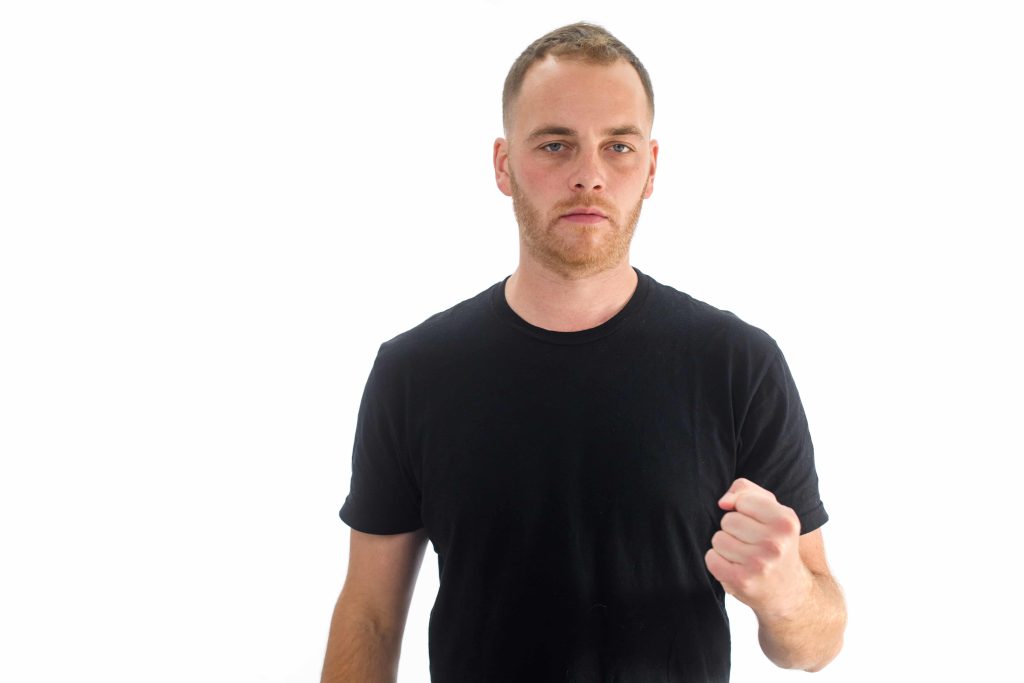
↑ Table of Contents ↑
Clenched hand
Anytime you have a solid fist, shaking it at someone or punching it in the air, you are showing intensity. Use it alongside a VERY important point. Be careful when using this gesture with an irritated voice because it can come off as anger!
Want to make a big, grand gesture? Then the "everything" gesture is your go-to. It is as if you are sweeping across all of the ideas to be inclusive.
Alternate: This can also be used to say you are wiping the slate clean or pushing something out of the way.
↑ Table of Contents ↑
Small, medium, large
This is a really easy one and can be used to literally show someone what level something is. You can use this to indicate how big or small something is or where someone stands. For example, you can use the high version along with "It's a pretty big deal" or the low version with "He's low man on the totem pole."
Alternate: You can also use this as you talk about different stages, as an alternative to listing. For example, you could say, "We start with your vision," (low level) "then move on to your structure," (medium level) and (most important level) "we end on your finished product."
↑ Table of Contents ↑
Let me tell you
Pointing should be used with caution. We don't like to be pointed at because it can be seen as accusatory or invasive. However, you can point to get someone's attention or to literally make a point. For example, this gesture goes along well with:
- "You know, I just remembered something important."
- "This one's important."
- "Let me tell you something."
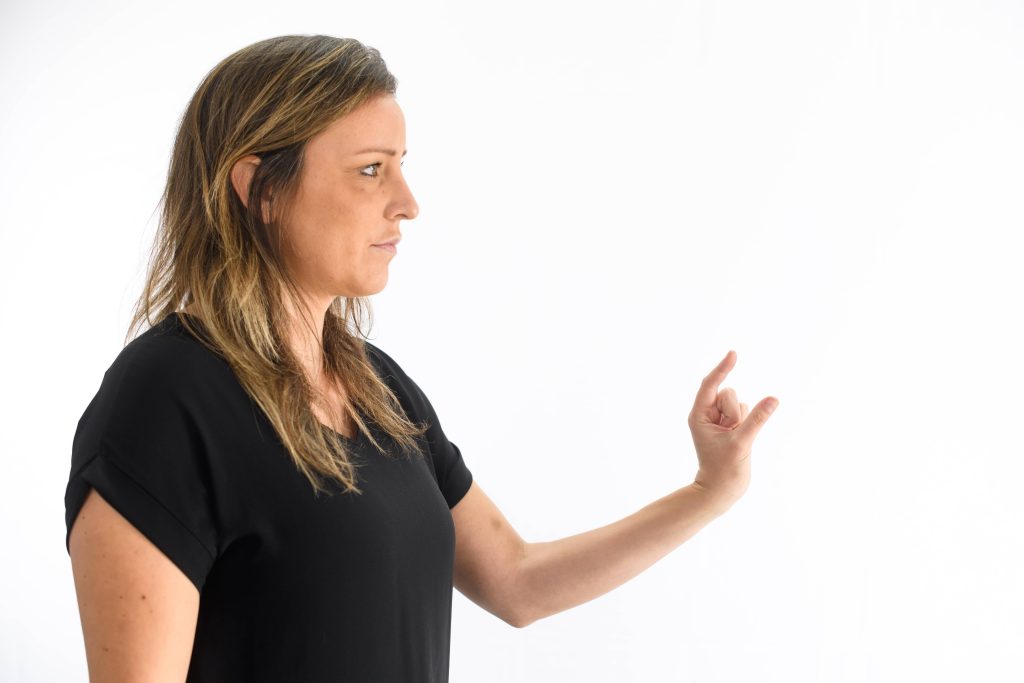
↑ Table of Contents ↑
Just a part
This gesture can be used to demonstrate a very specific part of an idea. When you are talking about an aspect of something, this gesture can indicate that it is separate.
Alternate: You can also use this gesture while turning your hand to indicate a change in perspective, along with "It really changed my mind from ___ to ___."
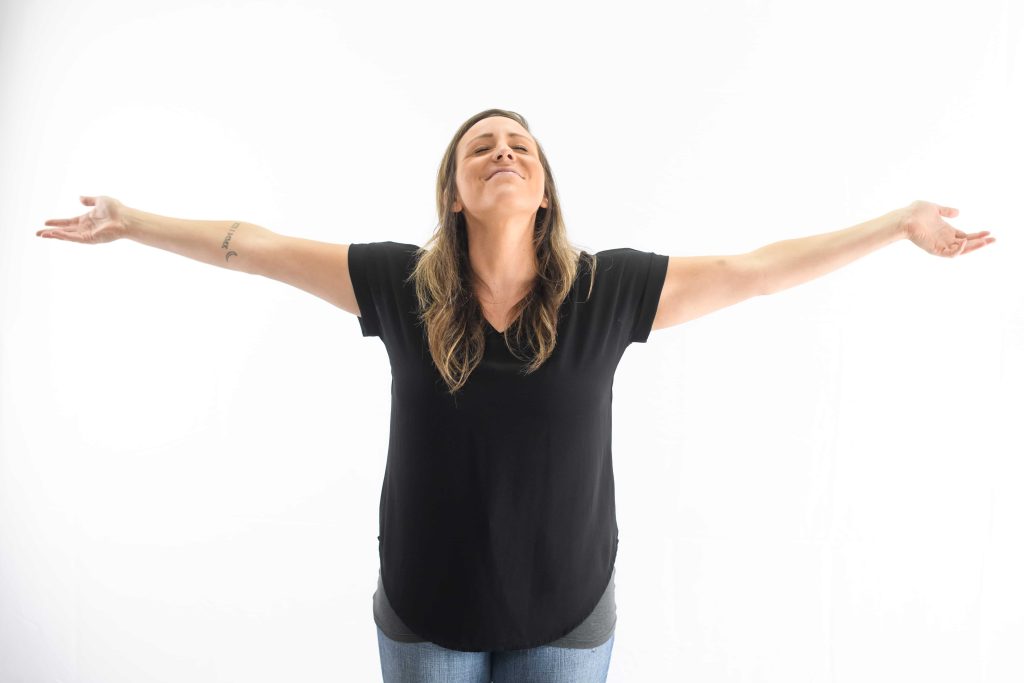
↑ Table of Contents ↑
I am magnanimous
When you have both of your hands apart and palms facing toward the audience, it is a very godlike pose. Use it when making a grand gesture.
How to Use it:
Here are a few ways to implement these gestures:
- First, try out 1 or 2 at a time. Too many at once is overwhelming.
- Second, I would use them on the phone first—where no one can see you—so you can practice and try without being worried about how you look.
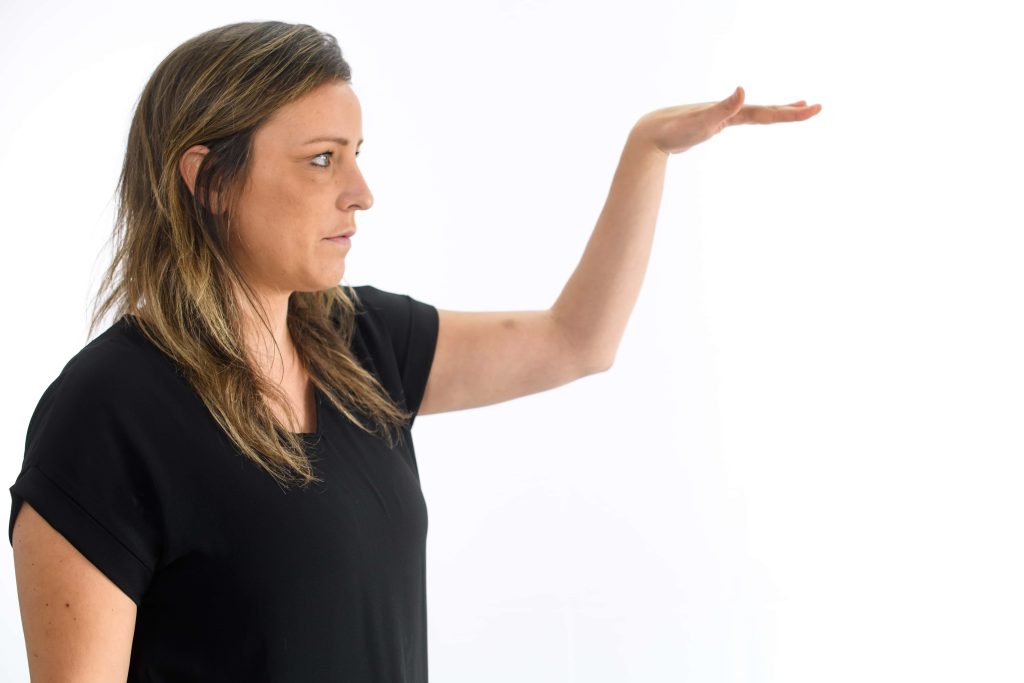
Whenever you move your hand or gesture upward, you indicate some kind of growth or increase. This can be used to indicate the expected growth, excitement, or direction where something is headed.
How to Use it: If you are an entrepreneur, you have to constantly show skyrocketing growth to investors. Often, this comes in the shape of a hockey stick chart—the one with a huge curve as time goes on. You can do this with your hands while you are speaking in a way to show (not tell) growth!
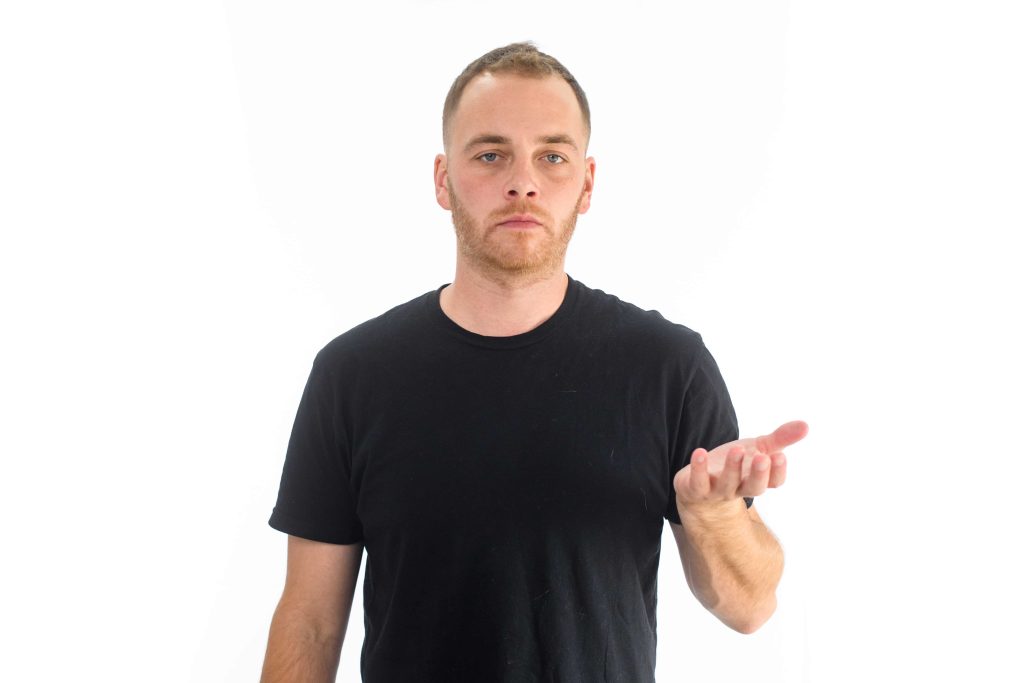
Any time you gesture into someone else's space or personal area, you tie them to your words. I like to do this with the open hand or palm, instead of pointing, to be more formal. Pointing is very aggressive. You can do the "you" gesture to make someone feel included or to highlight that something you are talking about applies to the person you are speaking with. It's a great attention grabber if someone's mind is wandering.
Special Note: Be sure to do this purposefully. I once was standing next to a woman who was overweight, and the man we were speaking with was talking about fast food and kept gesturing at her. She started to back away! It was a subconscious (and incredibly offensive) gesture.
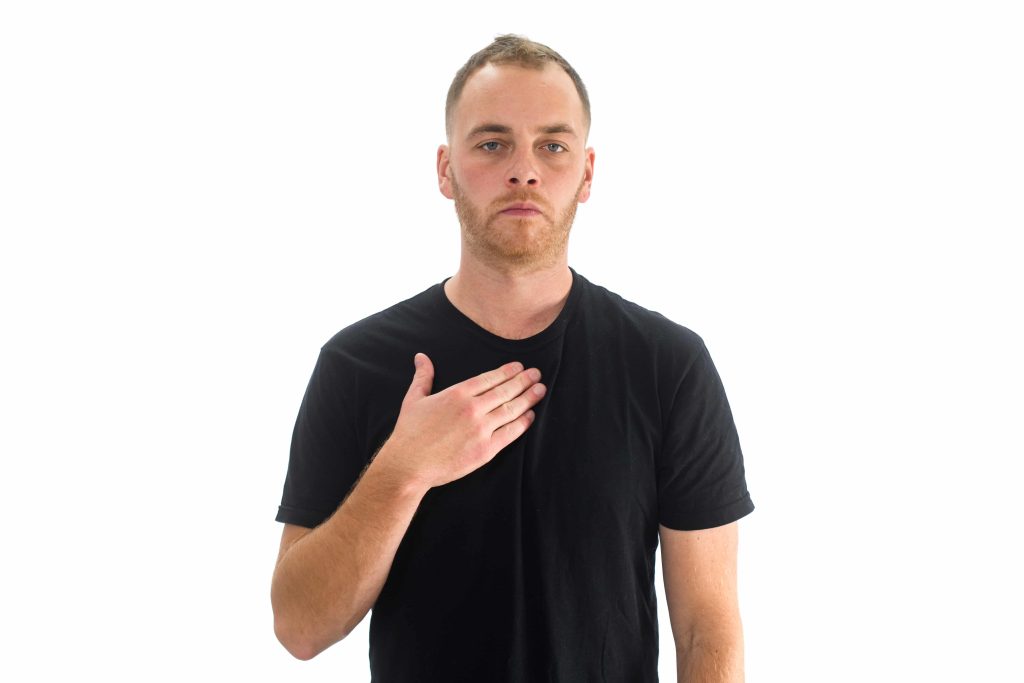
Anytime we bring our hands in toward our heart or chest, we usually want to indicate to ourself. I have even heard sneaky speaking coaches tell candidates to point toward themselves when talking about anything positive… Use it carefully!
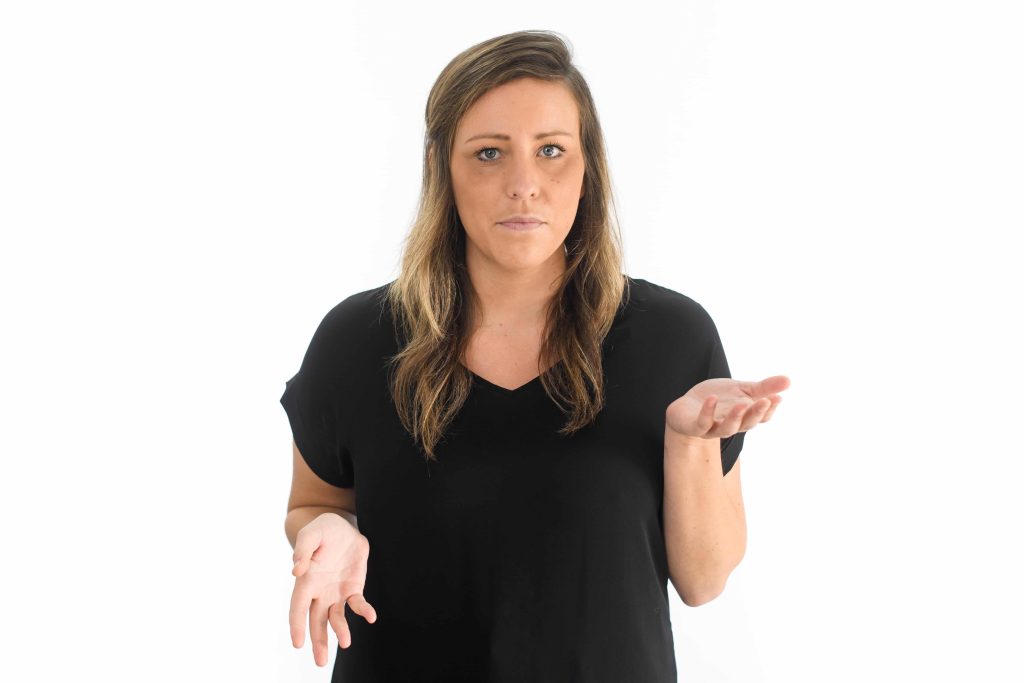
↑ Table of Contents ↑
This and that
Whenever you want to separate two different ideas or things, you can use your hands to symbolically represent them. For example, I might say we are totally different from them, using my left hand when I say "we" and my right hand when I say "them." This is a great way to put distance between two things.
Advanced: If you want to try something really advanced, you can use your hands to represent two different ideas. For example, if I were talking about Democrats and Republicans, I could use and raise my left hand when talking about Democratic ideas and actions and elevate and emphasize with my right hand when talking about Republican ideology and actions. This is both captivating and easier for the audience.
↑ Table of Contents ↑
Come together
When you bring both of your hands together, it is a gesture of combining and is a great way to symbolically show two forces coming together as one. You can even mesh or fold your hands together to show complete togetherness.
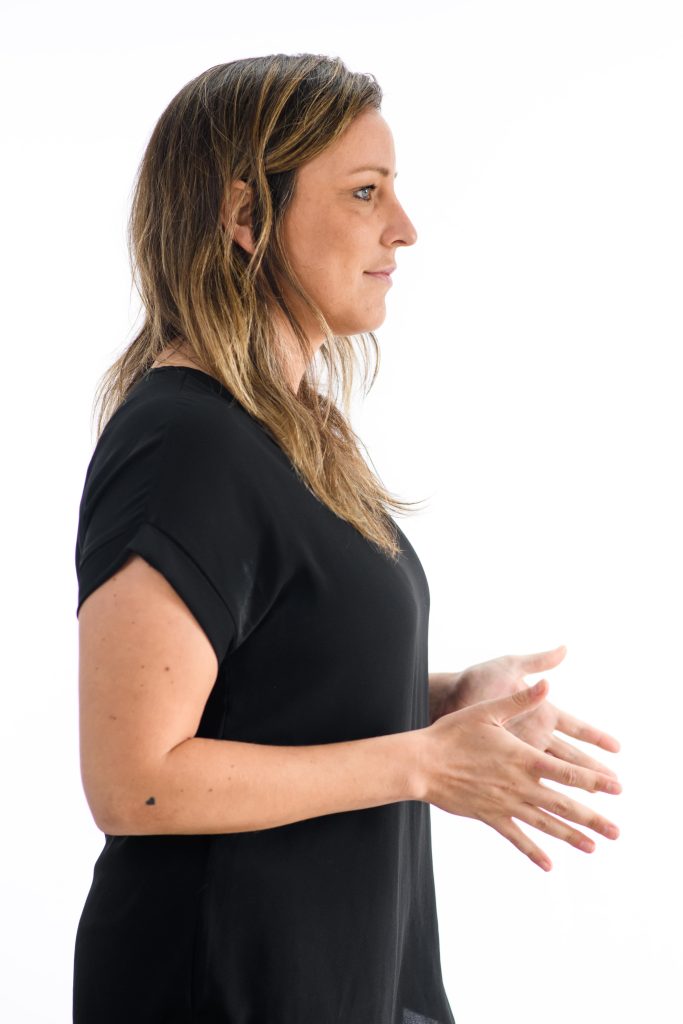
This is a typical gesture used when speaking and shows you're ready to go! You can use it to capture the audience's attention. This is a great gesture to use to garner silence right before you hook people into a great story.
↑ Table of Contents ↑
It's just so
You can use your palms vertically with a rigid slicing motion to demonstrate the need for precise measurement or to separate two things.
Alternate: This can also be used to demonstrate a tough stance on a point.
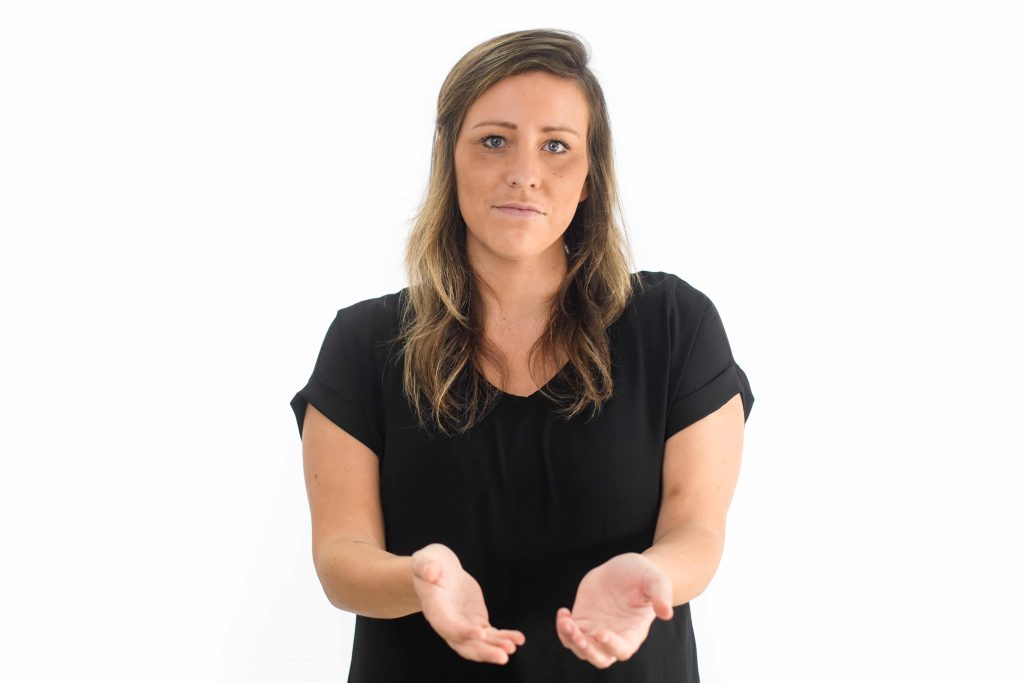
↑ Table of Contents ↑
I'm not hiding anything
When your hands are at a 45-degree angle with the palms facing up, you are showing openness and honesty. It's like you are saying that you are laying it all out on the table.
Alternate: When your palms face upward with fingers spread, it means you need something.
↑ Table of Contents ↑
You listen to me
The palms-down position shows power and dominance—it's not very positive, but it is commanding. If you have a very strong directive or order, you can use it. Be careful not to use this gesture by default! Hands should be facing up, out, or vertically when speaking. Always having them in the down position is very dominant.
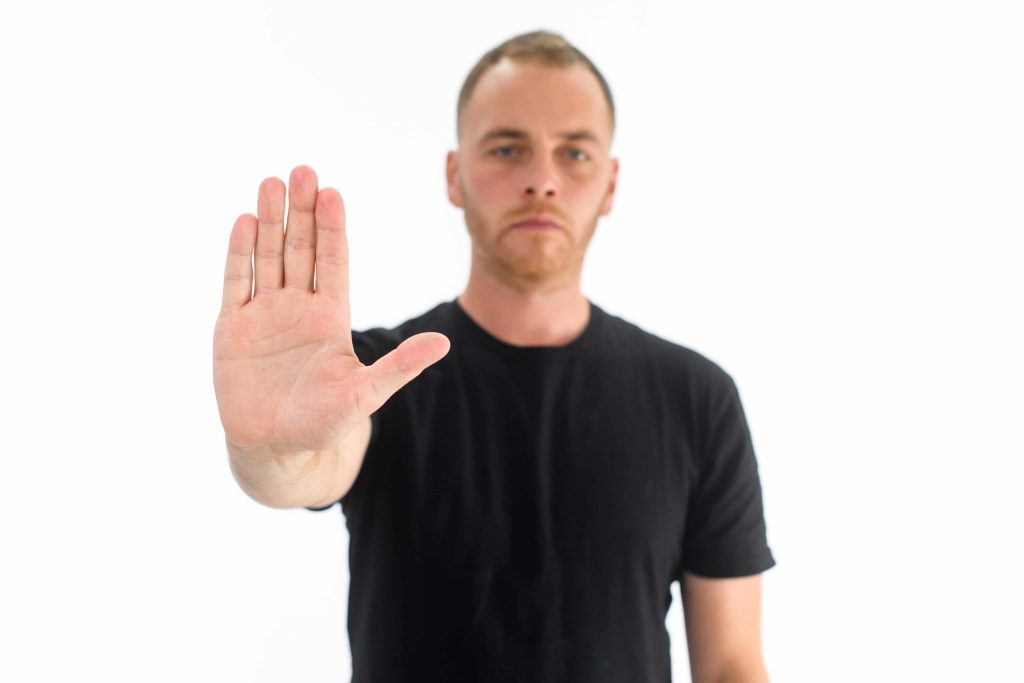
When you flash your palm at someone, you want them to pause or stop. You can do this while anyone is speaking, and they will almost instantly be quiet (use in emergencies only!). I was with a CEO once, and he had the habit of doing it to his employees when he was done listening. It was horribly offensive.
Alternate: You can also do this when asking a question—it's a universal attention grabber.
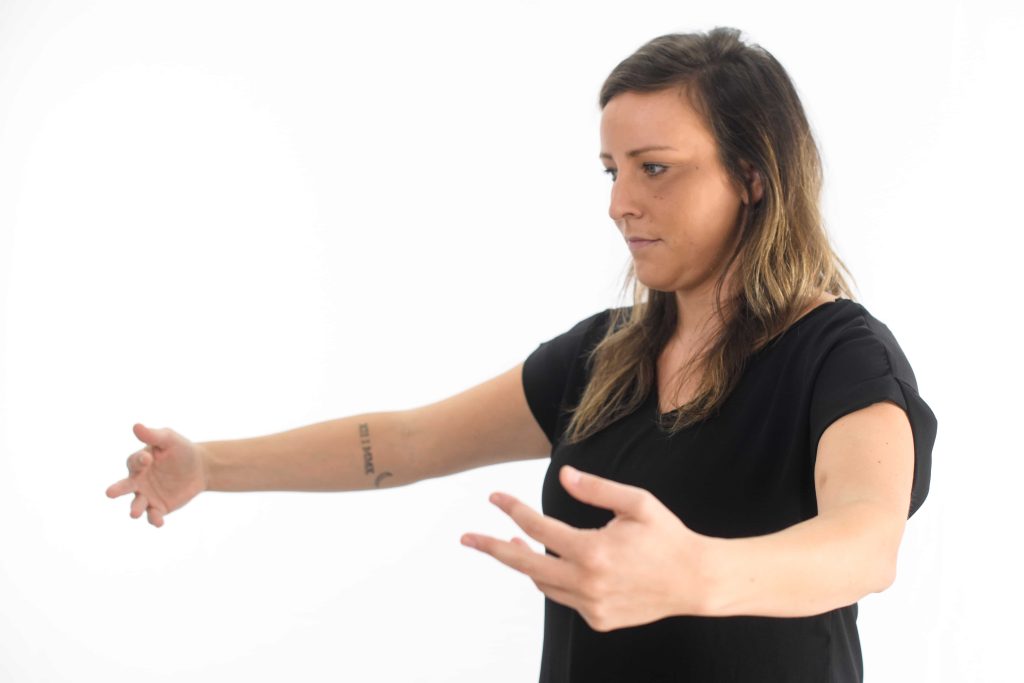
The last one can be the most powerful. This gesture can be used whenever you are speaking in a group or to an audience. You open up your arms, as if you are wrapping the audience in a hug, making the "we" gesture. You can also do this when standing next to someone and actually placing your hands behind them as if to indicate "you are in my inner circle." It is a lovely "come together" gesture when used correctly.

↑ Table of Contents ↑
22 More Popular Hand Gestures to Talk with Your Hands
Want to expand your hand-gesture knowledge? We've expanded this list to include even more hand gestures! Starting with…
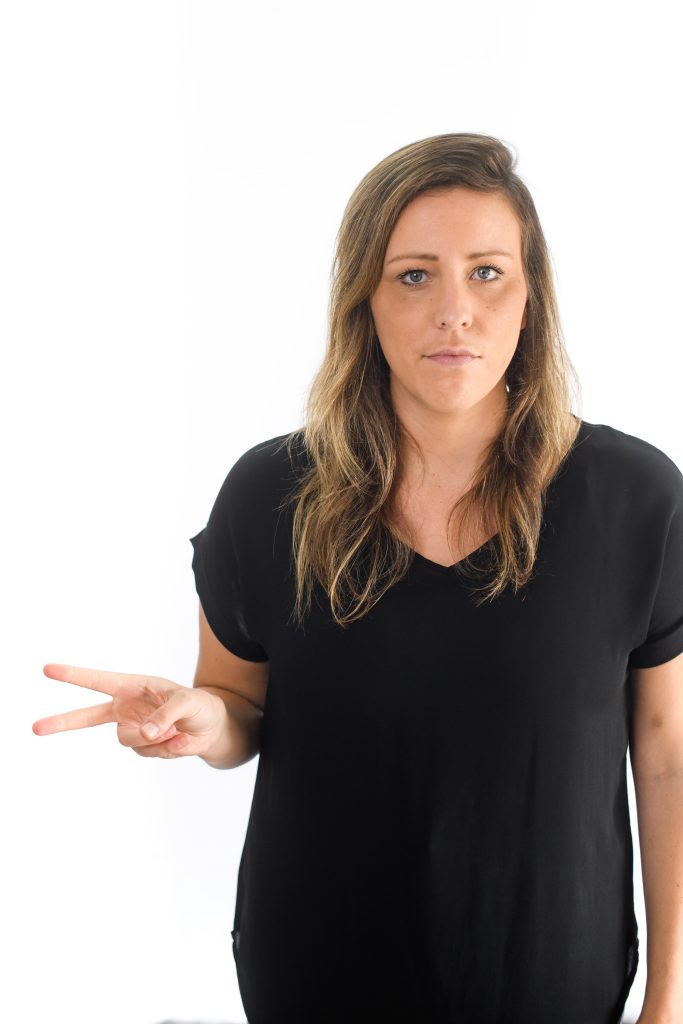
↑ Table of Contents ↑
I'm victorious
What it Means: The V sign with 2 fingers can commonly mean 4 things:
- the number 2
- victory
- "what's up"
- peace
And I know what you might be thinking…
"What about the other thing? You know… that one meaning?"
Alright, you got it—If you turn the palm facing yourself, it becomes a sexual insult. This is common in places like Great Britain. PM Margaret Thatcher made this mistake and essentially said, "Screw you," to a crowd of people1.

In other countries like Great Britain (seriously, what's up with you and the V sign, Great Britain!?), it could mean a rather nasty phrase: "Up yours!" But most people use it for the "good" meanings. For example, Winston Churchill made this famous as a sign for victory during WWII2.

↑ Table of Contents ↑
This is deep
What it Means: The accordion-player hands looks like someone is… well, playing the accordion! Great speakers tend to do this when discussing a subject that has a lot of depth1.
How to Use it: Do this when talking about a substantial topic. It mentally "primes" the reader that what you're saying has deep meaning.
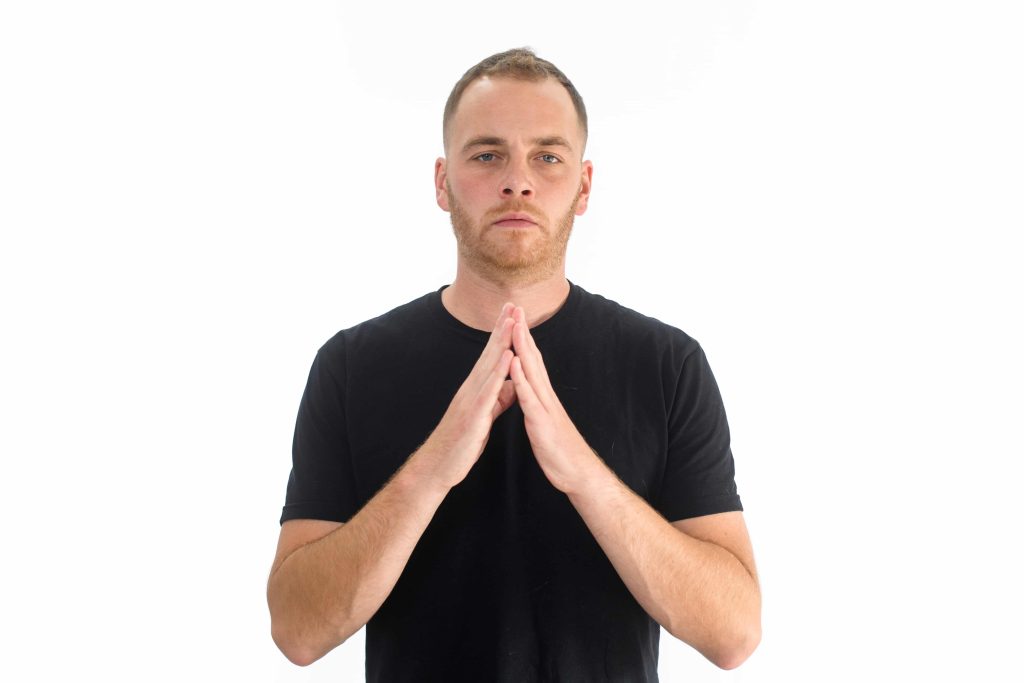
↑ Table of Contents ↑
Steepled fingers
This is one of Kevin O'Leary's (from Shark Tank) favorites. A steeple is when you lightly tap the tips of your fingers together. It is seen as a wise gesture, but don't overuse it. These days, everyone is trying it out.
What it Means: This hand gesture, also known as tented fingers, says, "I've got my sh*t together." It's called steepling because when done, it looks like the hands are pointed like the top of a church steeple3.
Ray Birdwhistell, who studied body movements, found that confident, high-status people who don't use a lot of body gestures often steeple their hands to demonstrate a confident attitude. This includes people like lawyers, accountants, and investors.
According to the Behavior Panel, when there is a large space between your thumb and your index finger, this indicates confidence. The larger space, the more confident you are.
Even more interesting is how the steeple can change during an interaction. Within milliseconds, the steeple can turn into a fingers-interlaced position and back to a steeple, signaling the ebb and flow of assurance and doubt3.People can also turn the steeple into prayer hands to attempt to appear more godlike2.
Try it! Try steepling right now. How do you feel? You might not feel like the Incredible Hulk, but do you feel more powerful? Steepling is one of the most powerful hand cues we have to increase confidence and power.
How to Use it: Want power? Steeple to gain authority and assertiveness in shaky situations. This can easily be done to inspire confidence in yourself and others during a meeting or interview. For example, when a prosecutor is steepling as his witness testifies, the value of the testimony is enhanced because the attorney is perceived as being confident of the witness's statement3.
Steepling is an easy one for females, in particular, since it is seen as assertive, not aggressive. You might also notice your boss do this move without even realizing its power! However, try not to steeple in front of others who want dominance—this might lure you into an unwanted power struggle.
Special Note: I have found that when I use this gesture, it centers and calms me. I have not found any research to back this up, but when I do this, it's almost as if I feel more centered and have an easier time taking deep breaths. It is similar to the prayer gesture. Anyone else experience this?
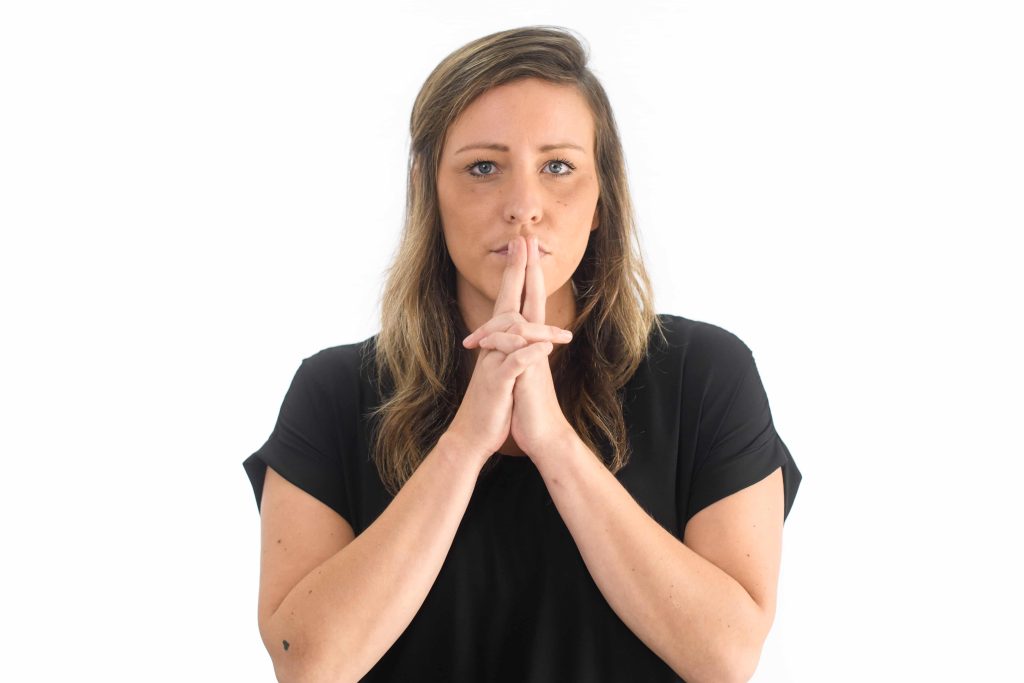
↑ Table of Contents ↑
Handgun steeple
You may see all the fingers interlaced except the index fingers in what is known as a "handgun steeple" because it looks like a gun that's ready to shoot.
What it Means: The handgun steeple is a nonverbal "screw you!" This type of steepling puts emphasis on what you're saying and is a more aggressive form of steepling that can be seen all over the news during political season4. It can also be used to shoot someone's ideas down (yikes!).
How to Use it: Use it to say you mean business, like if you find yourself on the bad-cop side of an interrogation. Never use it to establish a cooperative team environment unless you're aiming to be a dictator.
↑ Table of Contents ↑
Angela Merkel hands
Here's a question you may be asking: What is Angela Merkel doing with her hands?

Or who the heck is Angela Merkel in the first place? (She's the chancellor of Germany.)
This is known as the low steeple, Angela Merkel's favorite gesture. It's similar to a normal steeple except the hands are brought lower, around the belly area. It's more often used by women and when someone is listening rather than talking2.
What it Means: The low steeple signals confidence, but it's not as powerful as the high steeple. I'll often see women doing the low steeple when they feel in charge but are too afraid to be too dominant. If you see the low steeple, a person may be set in their opinion about the topic being discussed.
How to Use it: Since you'll often see this cue from a listener, the key to deciphering if he or she is in agreement with you is to look at other positive or negative cues before and after the low steeple. Positive cues can include:
- open arms
- smiling
- head nodding
These cues are a good sign they will say yes if you're negotiating a deal or in a business meeting. Negative gestures you may see include:
- leg crossing
- looking away
- pursed lips
All these indicate they may disagree or say no.
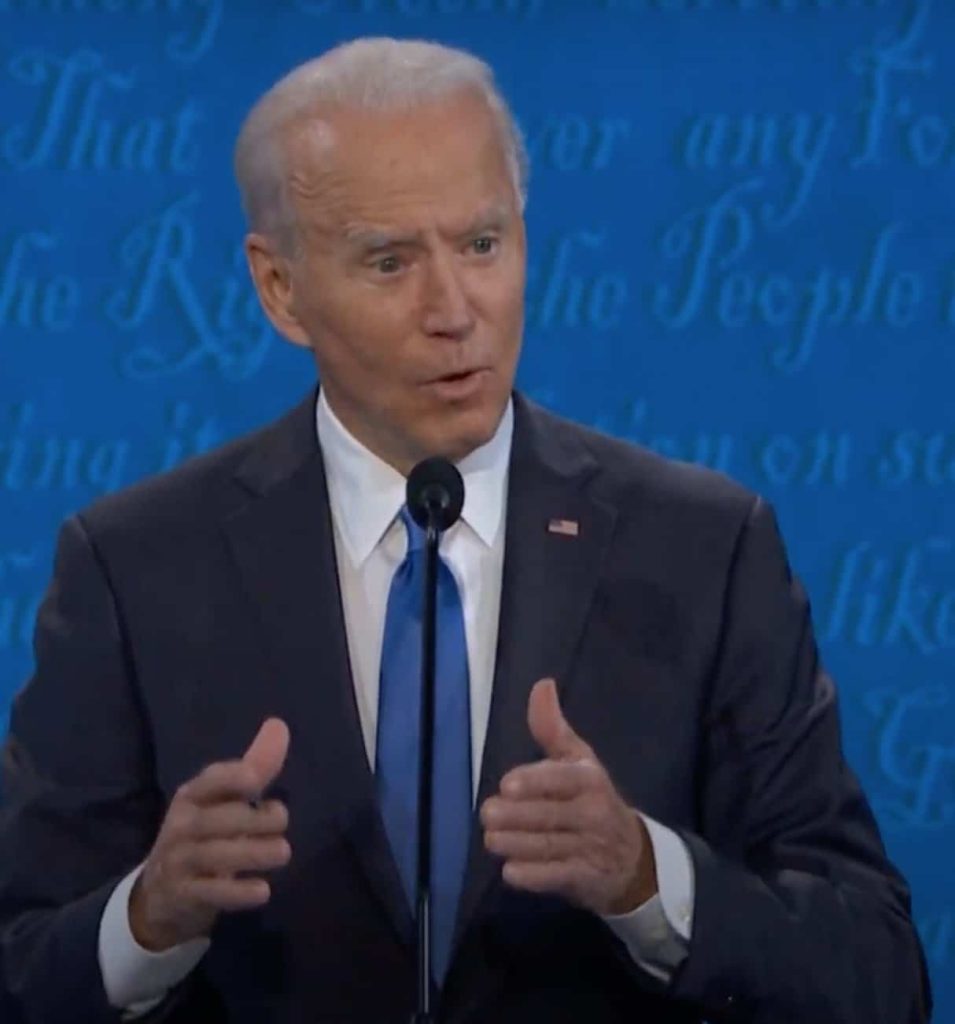
↑ Table of Contents ↑
Let's play ball
The basketball steeple is when the hands are in the steeple position in front of you, but there is a space between them like you're holding an imaginary basketball.
What it Means: This is a power gesture and is used when people want to get you on "their side." You'll often see this one during persuasive presentations from enthusiastic speakers who are confident in what they have to offer.
How to Use it: This is the most powerful steeple to get others to begin to agree with and believe in you4. It gives off a flair of likability while also maintaining power, so use this one sparingly during your main arguments to win some serious brownie points.
This gesture includes all hand movements that aim to make a person look better5. These include:
- adjusting a tie
- repositioning a bracelet
- smoothing out wrinkles on a shirt
- fixing hair
- reapplying lipstick
- plucking eyebrows
What it Means: Preening shows we care enough to want to look our best. We'll often preen when we meet strangers, want to make a good impression, or before and during a big date to maximize our attraction.
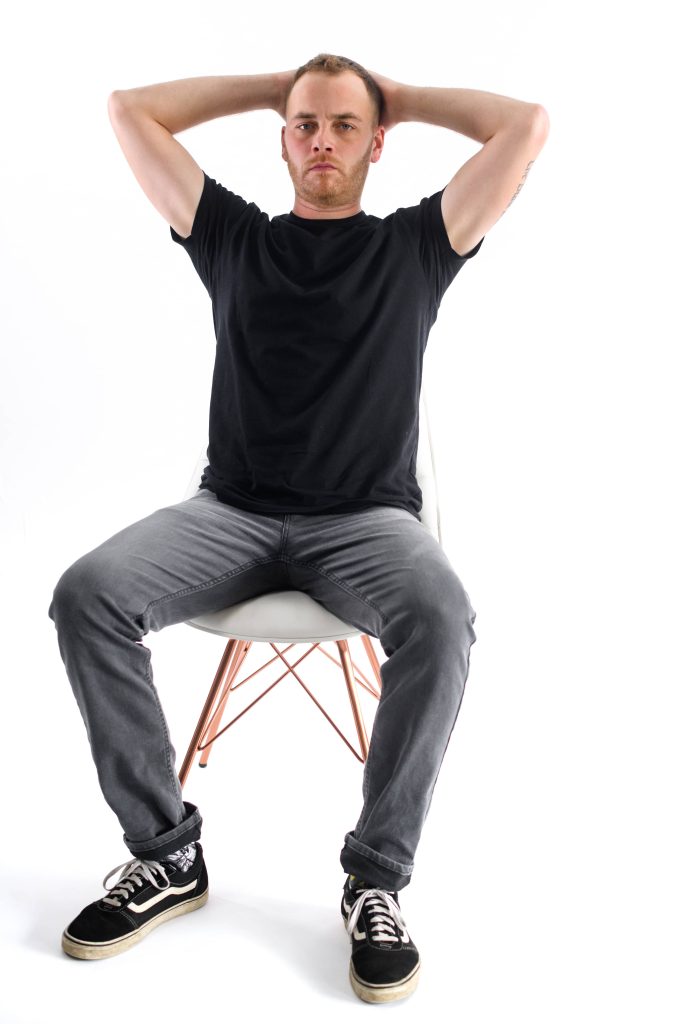
↑ Table of Contents ↑
I am important
How to Use it: Preening may seem superficial at first, but studies show it's a good thing: when attorneys do something so simple as pulling at their jacket as the jury enters the room, they are subconsciously perceived by jurors as more likable5.
What it Means: This is a hand gesture done when sitting and indicates high confidence since the elbow is pointing up. It's also high on the territoriality chart since it takes up space and can be used to invade others' personal boundaries3.
How to Use it: Feeling dominant in a group and have something important to say? Plant your hand on your leg to show others you mean business.
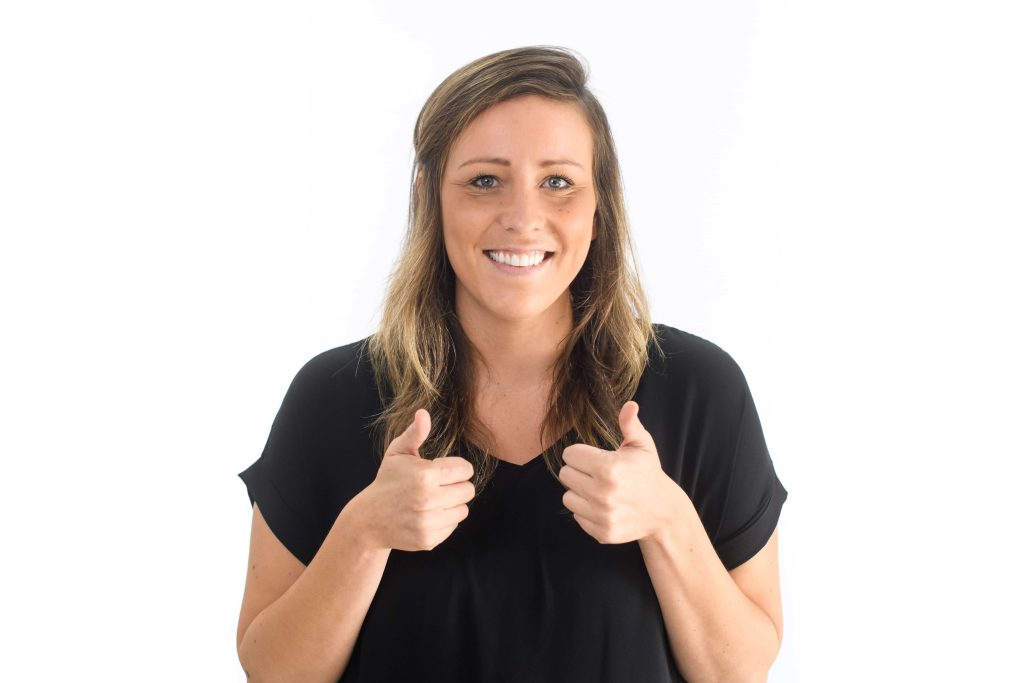
What it Means: If you're from the Western world, thumbs up obviously means "good." But it can also be used for many other situation1, including:
- acknowledging a favor granted
- greeting someone
- requesting permission to carry out an action
- indicating understanding
- signaling to a waiter
- as a sexual insult
How to Use it: As a general rule, your thumbs should be showing if you want to portray confidence. Thumbs are a good indicator of agreement, and even powerful leaders will use their thumbs when gesturing:
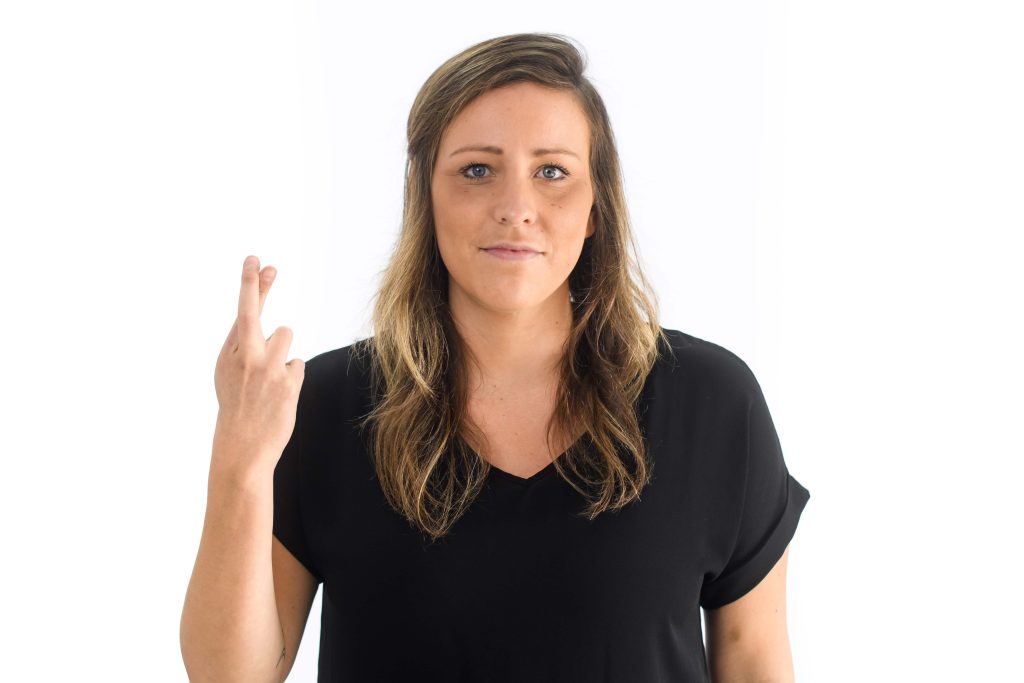
↑ Table of Contents ↑
Fingers crossed
What it Means: The fingers-crossed gesture typically means good luck and references the phrase "Keep your fingers crossed." But did you know it actually originated as an ancient protective device of the Christian Church, as a sign of the cross6?
How to Use it: Cross your fingers to add a bit of luck—but it will probably work only if you believe in it!
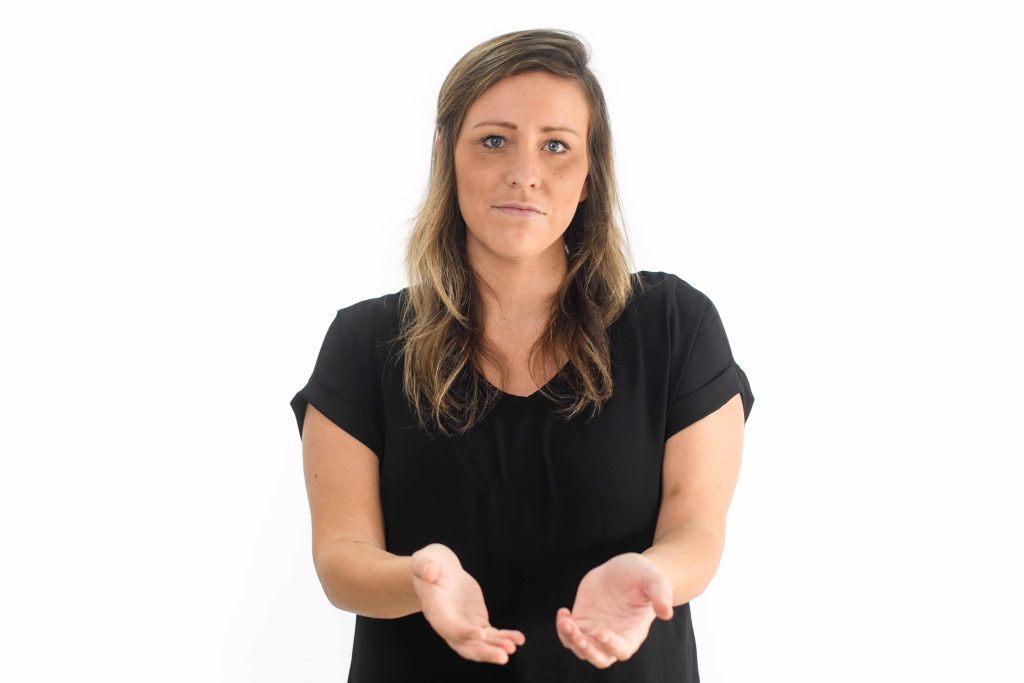
↑ Table of Contents ↑
I'm innocent
What it Means: This gesture is a very submissive, nonthreatening gesture that we love to see. When we see others' palms, it tells us they are not brandishing weapons or concealing something potentially dangerous. We're also seen as more credible and open when having open palms because it is more difficult to tell lies with our palms like this2.
It's also a common gesture used by street beggars, so use this one wisely if you want to appear favorable.
How to Use it: Use this when there's skepticism in the air or you're trying to unrattle a tense situation. This is to signal to others to not feel threatened or have no pressure when you're vying to win a negotiation. When talking, you can also use it as a "hand over" signal to let others know it's their turn to talk.
The Most Positive Gesture
In one experiment, 8 lecturers were asked to use 3 different hand gestures (palms up, finger pointing, and the fingertip-touch) during a series of 10 minute talks to a range of audiences2. The question was: How do audiences feel about these gestures?
Lecturers who used mostly palms up received 84% positive testimonials, 52% when they delivered the exact same presentation to another audience using palm-down, and only 28% were positive when they used finger pointing, with some participants even walking out during the lecture!
Participants also recalled less of what the speaker said during the lecture with finger-pointing, and described them as aggressive, belligerent, and rude.
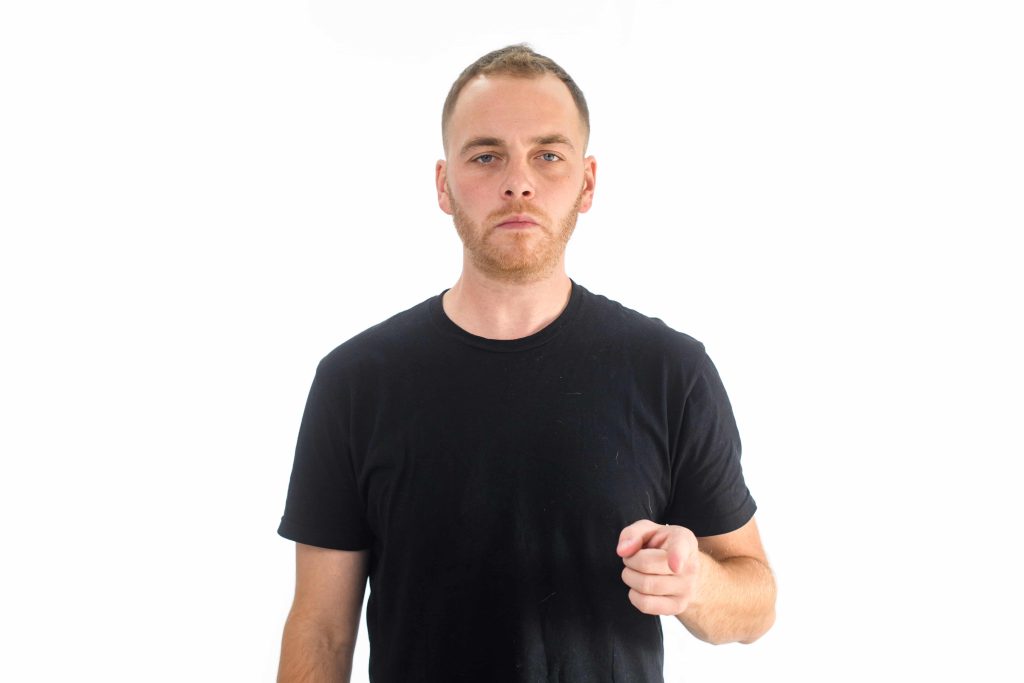
↑ Table of Contents ↑
I recognize you!
What it Means: Remember when Mom told us, "Don't point at strangers"? Normally, pointing directly at someone IS a rude gesture.
However, when done in an enthusiastic crowd, such as during performances, speeches, or parties, it can signal that someone is popular and knows a lot of people, or they are genuinely happy to see people.
How to Use it: Here's a party trick if you're stuck talking to someone and want an easy exit from a conversation: Point to the way back of the room, give a quick eyebrow flash, and pretend you recognize someone while moving toward the back. This works because crowd pointing can be used deceptively to give off an illusion of knowing someone or even of popularity. For example, Hillary Clinton is a master at crowd pointing. Watch as she uses this gesture to boost her social value before giving her speech (timestamp 0:28):
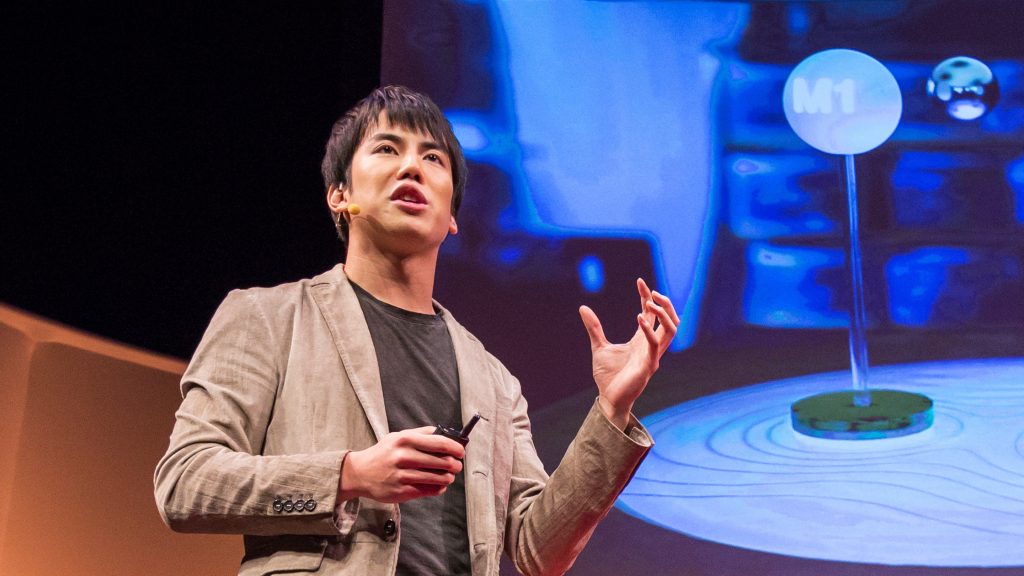
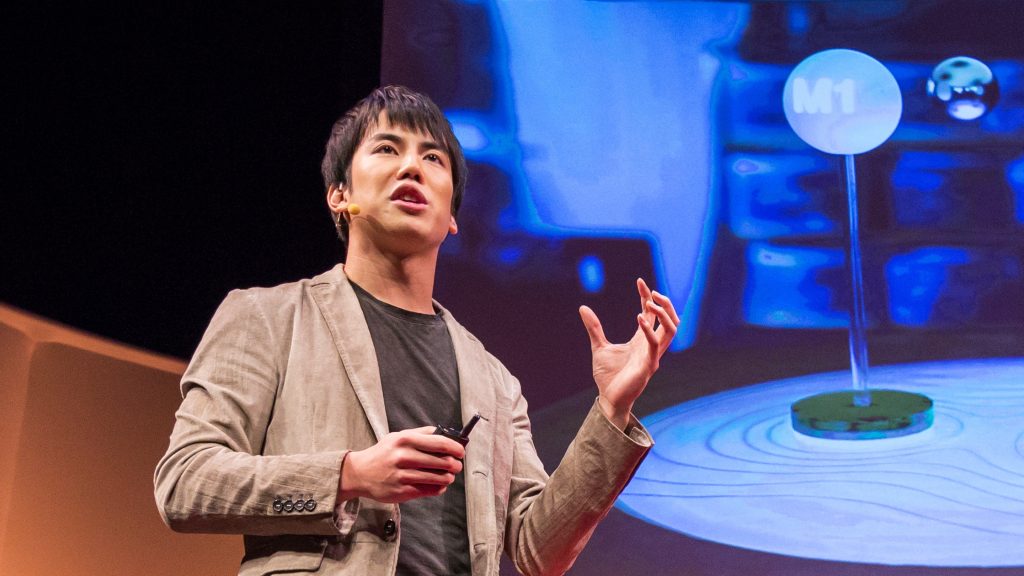
What it Means: This gesture is typically used when addressing an audience as a speaker. It's authoritative but honest, since the palms will usually be in an open position.

Body Language expert Greg Hartley mentions in a video that a witness is holding her illustrating hands in front of her while describing a UFO event. This implies that she's telling the truth since those who are lying usually hold their hands to the side. You can watch the full video below:
How to Use it: Use this cue to emphasize a big point or address an important topic.
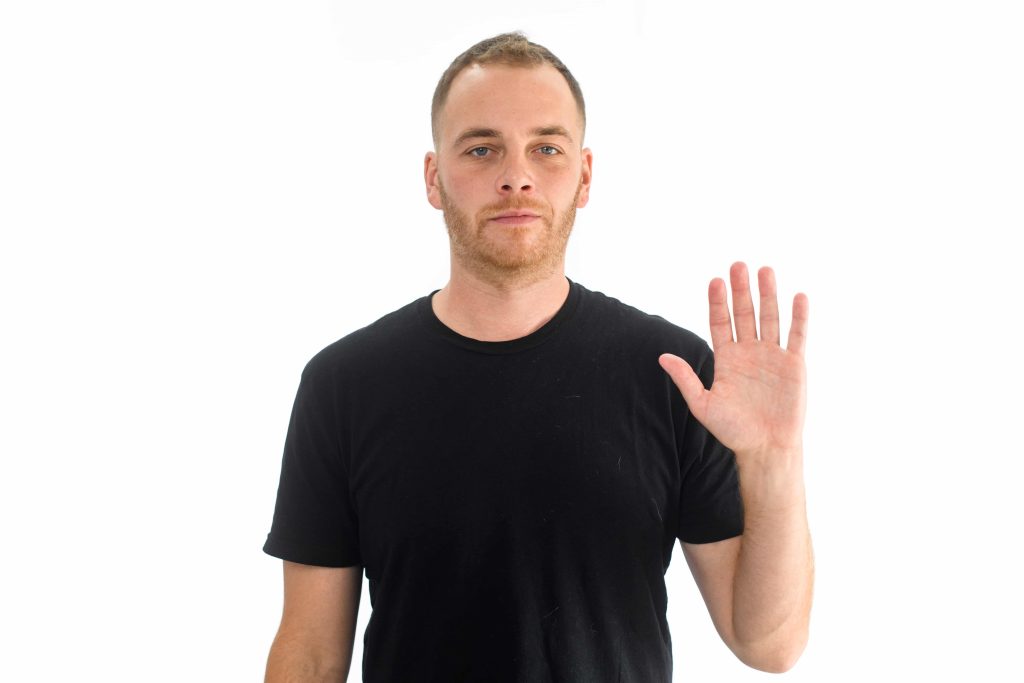
↑ Table of Contents ↑
The single wave
This is the standard hand wave used across the world.
What it Means: Hello! I love the wave. I use it every time I greet someone because it says, "friend, friend, friend!" Here's a fun fact: Did you know that fiddler crabs wave their claws at females in order to attract them?
It works because waves are attractive and one of the best rapport-building openers you can use. It is also a submissive cue—on another animal note, arm waving is something bearded dragons do in the wild to signal to others they mean them no harm and are not a threat.
Waving has been considered a part of the mating ritual as well, with females often arm waving back at males who head bob at them.
How to Use it: Want to make waves with a spark of dopamine? A great way is to wave and get a wave back. I also make sure to keep the webcam back during all my video calls so people can see my wave!
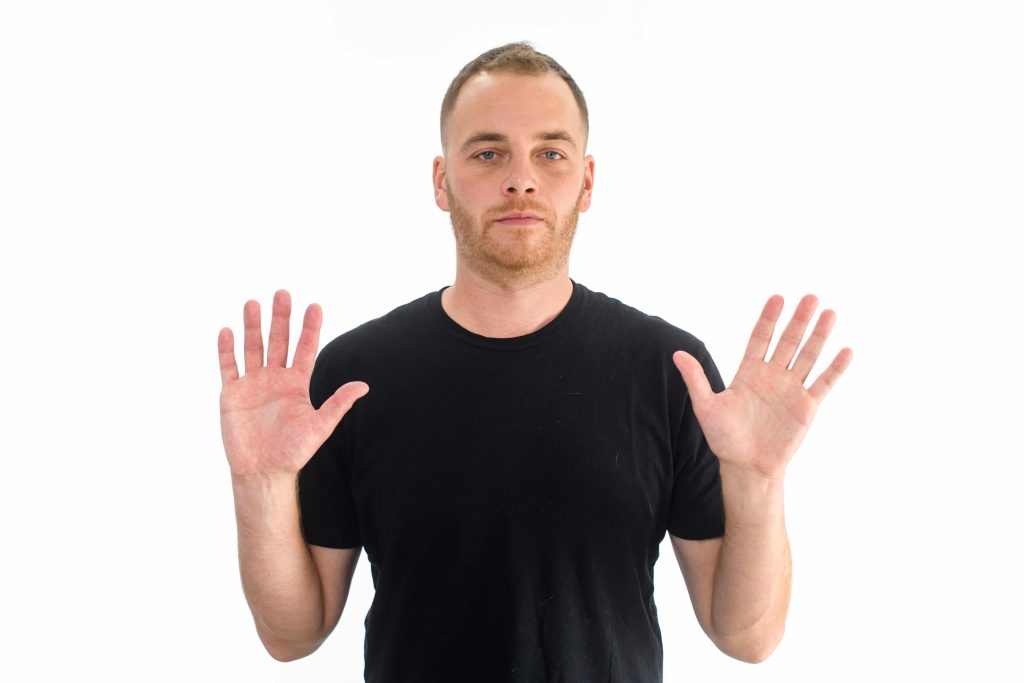
↑ Table of Contents ↑
The double wave
What it Means: Everybody knows the single-hand wave. Add in another hand and you've got double the excitement!
↑ Table of Contents ↑
Rubbing hands together
What it Means: This gesture is hand rubbing and indicates anticipation, thinking, or excitement for something that is going to happen. This is a GREAT indicator to see in business situations and screams "Gimme the goods!"
The speed of hand rubbing actually matters2.
- A fast rub means a person is expecting results to be in your benefit, not theirs.
- A slow rub means a person may feel devious or sneaky, with the results benefiting them and not you.
Here's a scene in Shark Tank where you can see Daymond John rubbing his hands in anticipation (timestamp 2:24):
↑ Table of Contents ↑
The hand purse
The purse can be formed when all fingertips come together on one hand and the palm is turned upward. It can also involve an up-and-down motion.
What it Means: Generally, this is used to show something is good. Often, the hand will "beat down" while key words are uttered.
The purse can also mean different things, depending on your location6.
- Greece and Turkey: "Good."
- Spain: "Lots of" something.
- Malta: Implies heavy sarcasm.
- Tunisia: Indicates caution, as in to take things slowly.
- France and Belgium: "I am afraid."
- Italy: "What's the matter, what's up?"
↑ Table of Contents ↑
The money pincher
This gesture is similar to the purse, but involves rubbing the fingertips with the thumb. Imagine a coin being rubbed between the thumb and fingertips.
What it Means: If the purse means "good," the money pincher means "Woohoo! Money!"
How to Use it: You can use this to indicate a good bargain; however, this gesture should generally be avoided by professionals because it carries a negative, greedy connotation2.
↑ Table of Contents ↑
The sand pinch
The tips of the index finger and thumb come together, almost as if pinching some grains of sand, with the palm facing downward.
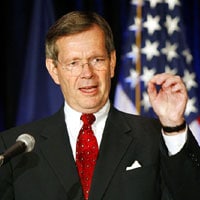
What it Means: This gesture can even be an OK gesture, but most often it's used by speakers to make a point or explain something important. The Peases taught this to groups of speakers, politicians, and business leaders and measured audience reactions—those who listened to the speakers using this gesture described them as thoughtful, goal-oriented, and focused.
Alternatively, it can also mean "perfect" in some parts of the world6.
How to Use it: Sprinkle this gesture throughout your speeches to help drill down things for your audience to remember. Bill Clinton, known for his powerful body language, often does this in his speeches to emphasize an important point:
↑ Table of Contents ↑
This is precise
What it Means: Other than… well, OK, the OK sign is often used by speakers as a precision cue to emphasize a point while speaking3.
How to Use it: You can subtly use this to let others know you're comfortable and self-assured by resting your thumb and index finger lightly on your leg. This will unconsciously trigger in your conversation partner's mind that you're actually feeling good4.
You may also "catch" someone lying with this cue4—if a person says their competitor's sales are doing badly, but uses this precision cue, then you can assume that they're actually doing well and catch him in a lie.
Don't use this when traveling to the Mediterranean or other countries like Brazil, however, as it can be used as a vulgar gesture and connotes an orifice3.
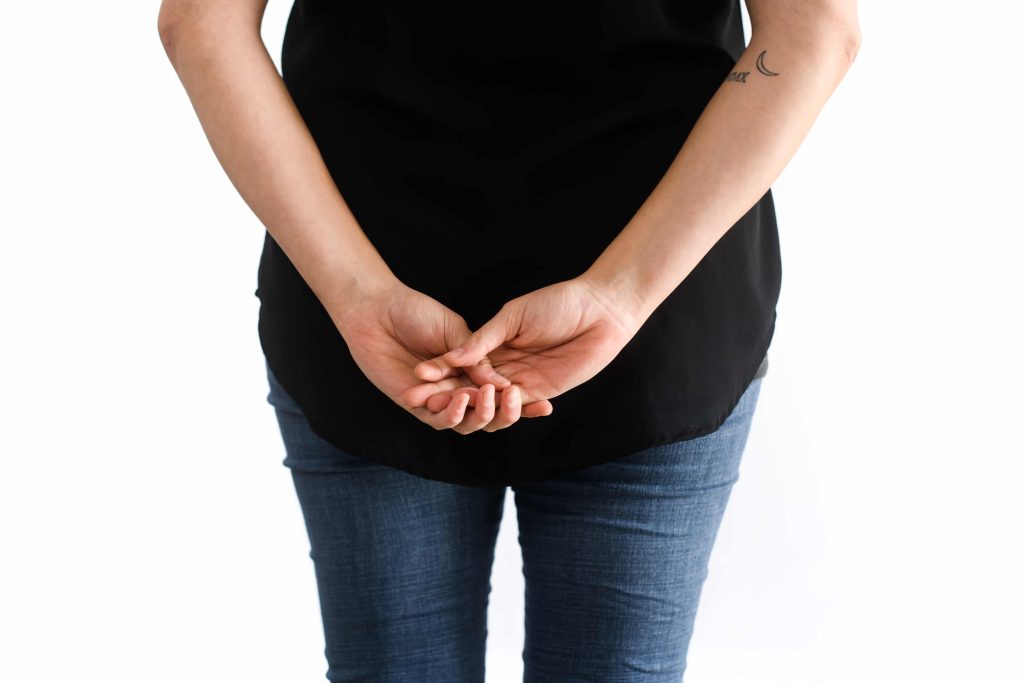
↑ Table of Contents ↑
Hands behind back
If one hand grabs the other arm's wrist behind the back, this is a classic "patrol hands" stance you might see from a security guard who is making routine patrols. It basically says, "I mean business." The pose is also common in people who are pondering in a relaxed, observant manner, such as walking through a garden.
What it Means: This stance exudes authority, and coupled with the chest puffed out, displays high confidence.
The hands behind the back is also viewed as a more formal or respectful gesture. It's a nonconfrontational gesture since the vulnerable front of the body is exposed without the hands to protect it.
In the Peases' work with law enforcement officers, they found that officers who don't wear firearms use this pose regularly while rocking back and forth on the balls of their feet. This lets them gain additional height and seem more authoritative.
Police who wear firearms, however, seldom do this gesture and instead hang their arms to the side or tuck their thumbs into their belt. But can you guess why? Because having a firearm gives the officer sufficient power, so the patrol hand gesture isn't needed.
How to Use it: This is a great gesture to use under high-stress situations. It gives you more confidence and authority when you need it the most2.

↑ Table of Contents ↑
12 Negative Hand Gestures to Avoid
What about negative hand gestures? Here are some negative gestures you might be using but are unaware of. Keep these out of your handy speaking toolbox!
↑ Table of Contents ↑
Please give it!
Have you ever seen someone ask—or even beg—for something?
What it Means: This gesture can be seen used by street beggars, flirtatious singles at night clubs, and even creeps.
The meaning is universal: "Come here!" The beckon is one of those gestures with many different variations:
The forefinger beckon:
The full-arm beckon (i.e., "Come over here, son!"):
The double-arm beckon:
The sideways-arm beckon:
The finger wave:
The provoker:
However, it can also be very deadly if you use it wrong…
The Deadly Swimmers
One day, 2 northern European swimmers went on holiday in the Mediterraneans¹. Feeling adventurous, they went beyond the tourist beach and found themselves approaching a restricted military zone.
Unfortunately, this zone was protected by armed guards who spotted the swimmers. Immediately, the guards thought they were spies. They beckoned to come ashore.
The swimmers, after seeing this gesture, realized they were in a restricted zone and turned away to swim back. Unfortunately, the guards saw them retreat, assumed they were actually spies trying to escape, and shot them with their rifles. Ouch.
So why did this happen? It turns out the guards used the Mediterranean beckon gesture, performed by taking the hand and sweeping downward with the palm facing DOWN.
However, the swimmers, not from this area, were used to the beckon gesture being performed with the palms UP. Seeing the guards use the palm down version made them think this meant "go back."
So depending on where you are in the world, the beckon can be different—the English and French often keep their palms upward, while Italians keep their palms downward. This rule can be applied to ALL hand gestures and body language cues:
Cultural differences can literally mean life or death (or, in most cases, a bit of embarrassment), so be mindful when reading body language.

↑ Table of Contents ↑
Hand holding arm
Arm touching comes in many forms—massaging, scratching, or resting the hand on the arm.
What it Means: Anytime someone touches their arms, it might signal one of the following:
- insecurity
- doubt
- anxiety
- stress
- uncertainty
When the arms are massaged, this cue is a self-pacifying gesture similar to the "self-hug." When it's combined with other gestures, you can be more certain of what this cue can mean. Be sure to check out our arm body language guide to know more about arm gestures to look for:
Body Language Guide – Crossed Arms and 17 More Cues to Know
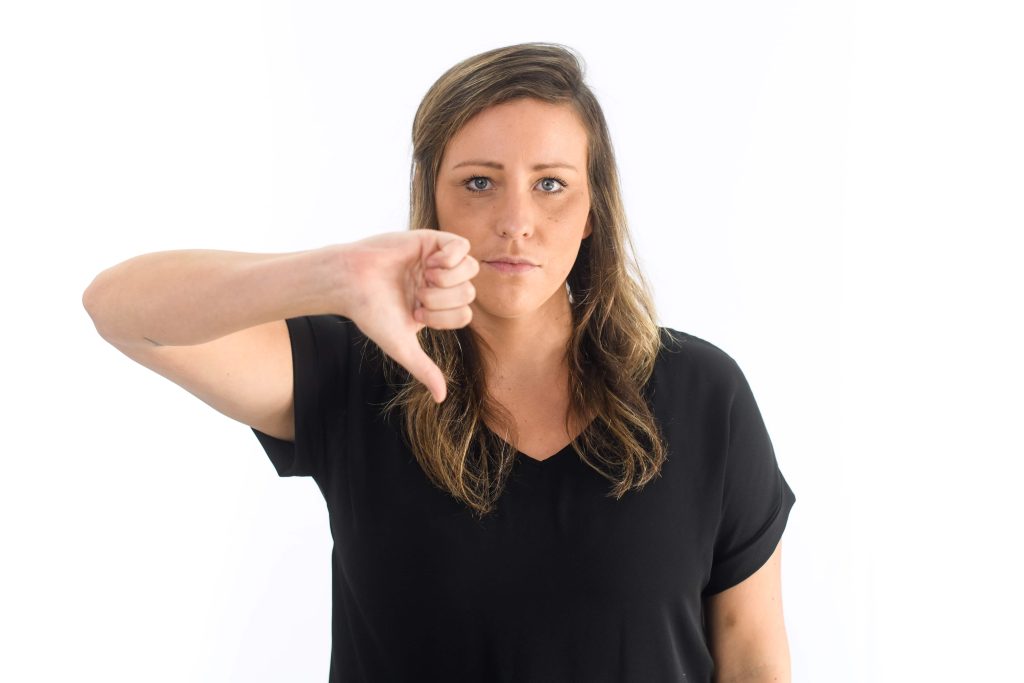
↑ Table of Contents ↑
Thumbs down
What it Means: You may know that thumbs down means "bad" or "no good"—but did you know this was also the Roman gesture that could spell death6.
Here's how this came to be:
When a gladiator was defeated in combat in the arena, he was either spared or killed on the spot by the victor. So who decided if he was spared or killed? The crowd of spectators.
If they wanted the loser to live, they would simply ball their fists outward. But if they wanted him dead… the crowd would point their thumbs to the contestants, which looked like a thumbs down, in the gladiator's eyes, and signaled a sword thrust to end the loser's life.
How to Use it: Generally, you shouldn't use the thumbs down position unless you want to create negative rapport. Big leaders will rarely be seen using the thumbs down position during their talks, and it can often be seen as childish to do so.
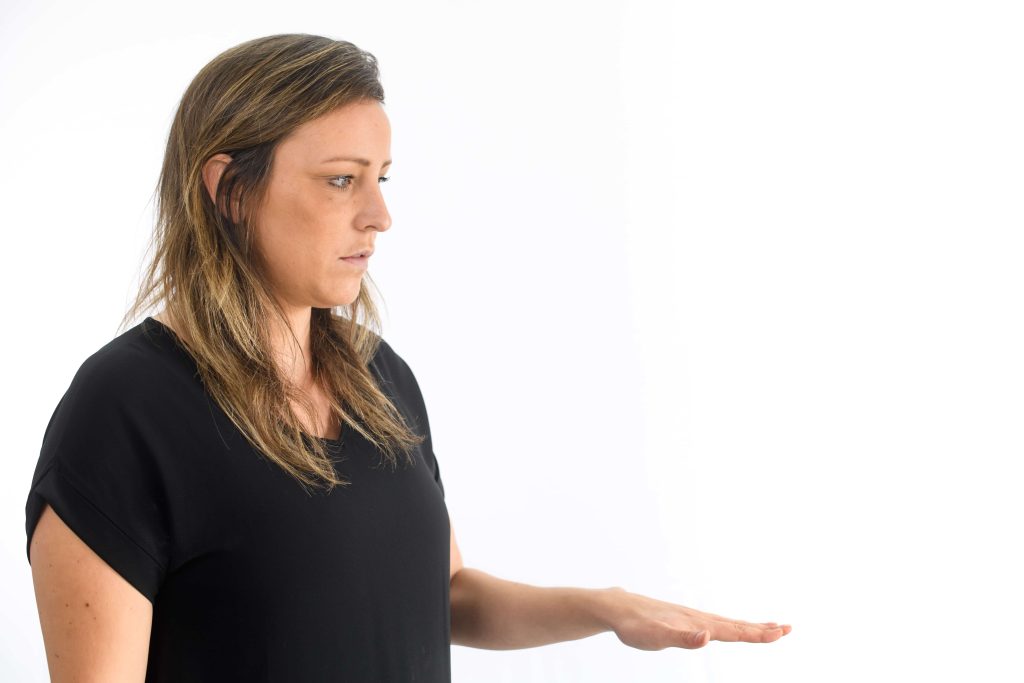
↑ Table of Contents ↑
Listen to me… or else
How to Use it: Generally, you don't want to use gestures with the palms down if you're not in a position of power. Others may feel it's an order and feel antagonistic toward you2.However, people in authority can easily use it to those below them since it's more acceptable.
But be careful of using it too much. Having your palms down is a very powerful gesture and is also associated with the Nazi salute.

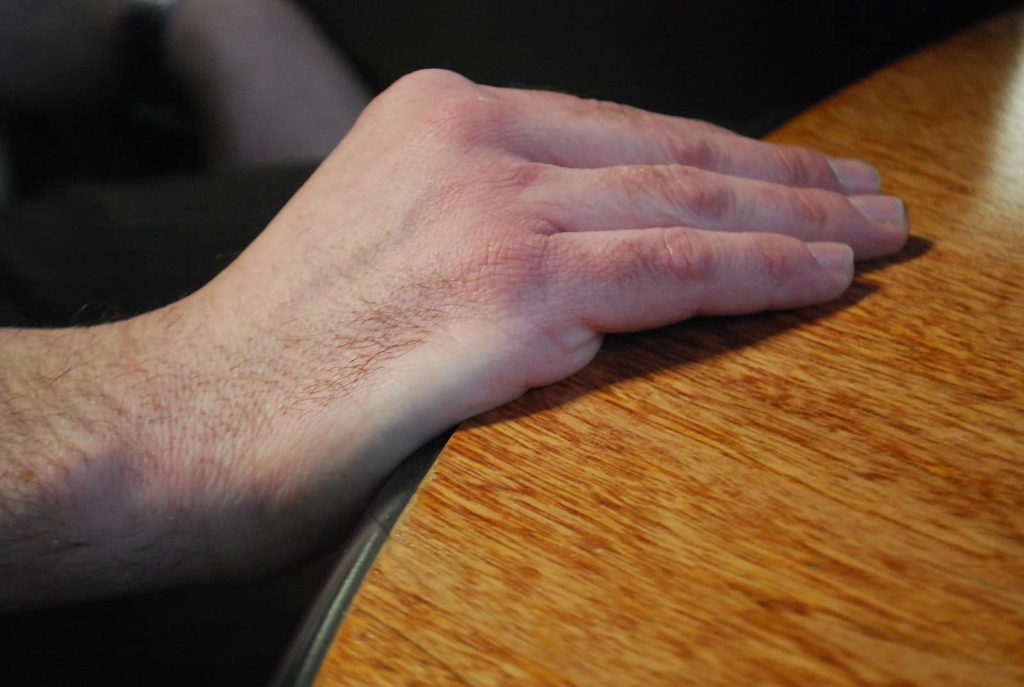
↑ Table of Contents ↑
Hand resting on table
What it Means: This is an affirmative display. If hands are lightly resting on the table, this can mean they are comfortable. But if they are pushing strongly down on the table, it's as if they're affirmatively saying, "I didn't do it"5.
People who are lying tend to struggle to put their hands down confidently on the table. In fact, Navarro has never seen a liar successfully pull this off.
How to Use it: Place your hands on the table with your palm down and fingers spread wide. This makes you look more authentic. You can also gauge honesty in others by checking their finger space!
A limp wrist is a wrist with no tension. You can try it out now—put your forearm parallel to the ground at around belly area and just let your wrists loose.
What it Means: The limp wrist is used mostly by women. And if you're on a date, great! This is a good sign of attraction. This is actually a display of weakness, like how a dog will tuck in its tail and let it droop down. Women do this because it lets men feel like they can dominate them.
How to Use it: The limp wrist is great if you want to appear submissive when flirting, but in business situations, this can be a deal breaker. Limp wrists can show you are too weak. In fact, I was guilty of doing this early on in my career. Here's a photo I found that sums up what I looked like:
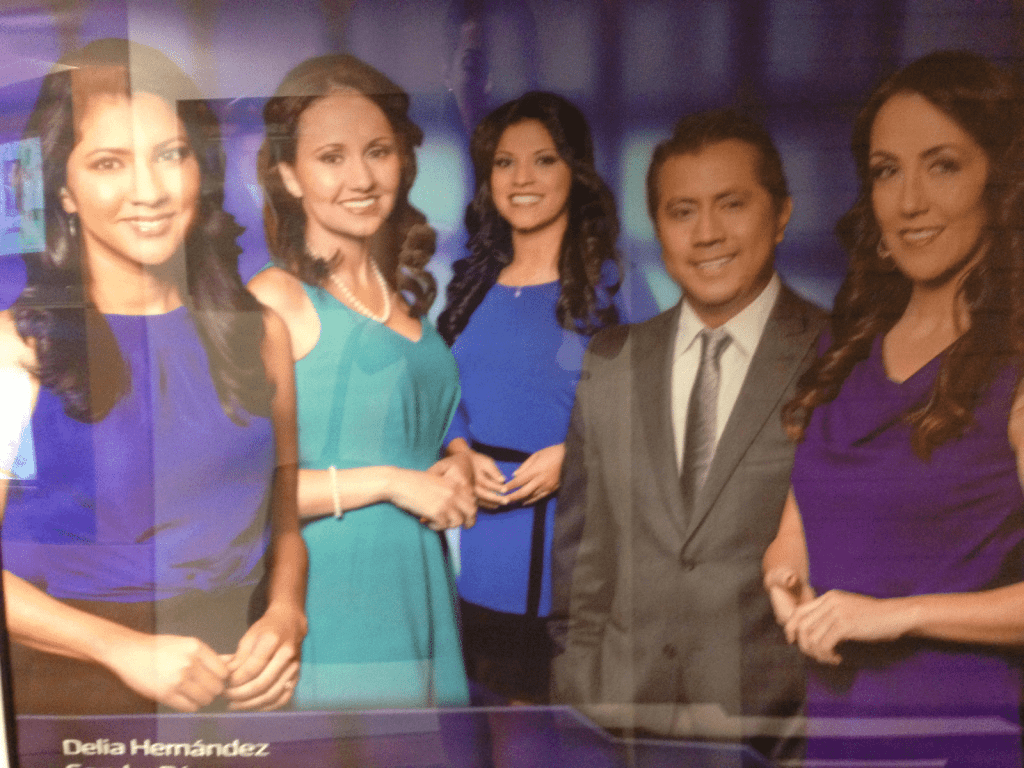
Notice how in the picture, the women are showing their hands but blocking their torsos with their arms. Their wrists are also limp. However, the man's hands are buried deep in his pockets, indicating a lack of confidence.
When the hands are out to the side and palms facing up, you've got the hand shrug.
What it Means: This is a universal "what do you know?" or "I don't know" gesture. Studies show that nurses make greater use of the hand shrug gesture when lying, as if to relinquish any responsibility for their verbal statements6.
Watch this clip as Bill Gates uses the hand shrug when he wins on The Ellen DeGeneres Show (timestamp 2:42):
How to Use it: The hand shrug isn't only for uncertainty. You can also use hand shrugging with a single hand to indicate something is either good or bad. Body language expert Chase Hughes says that people will tend to favor one side—for example, their left side for something good and their right for something bad.
You can then become more persuasive and build rapport by leaning and gesturing to their left while talking about your own product and leaning and gesturing to their right when talking about your competitor's.
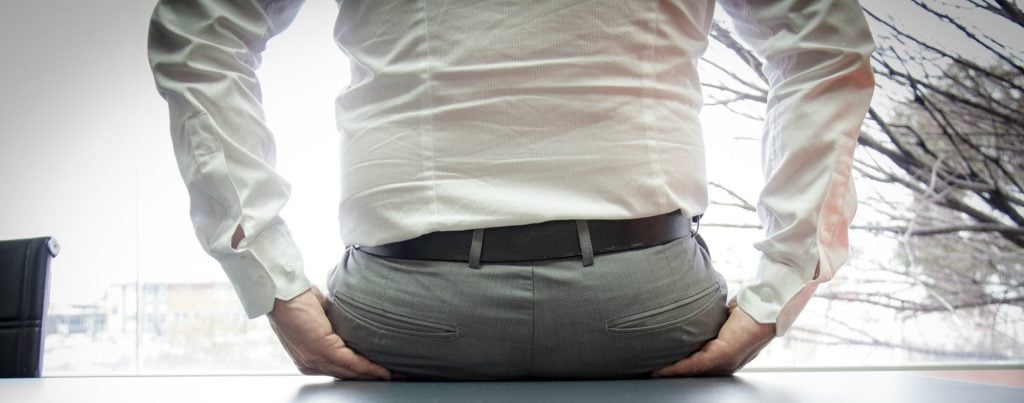
↑ Table of Contents ↑
The hand seat
What it Means: Sitting on your hands is similar to shoving them deep down into your pockets. You may see this gesture with kids and shy teenagers but rarely in the business world. This is a super closed-off gesture and should be avoided. Instead, show your hands and open them up to make a good impression.
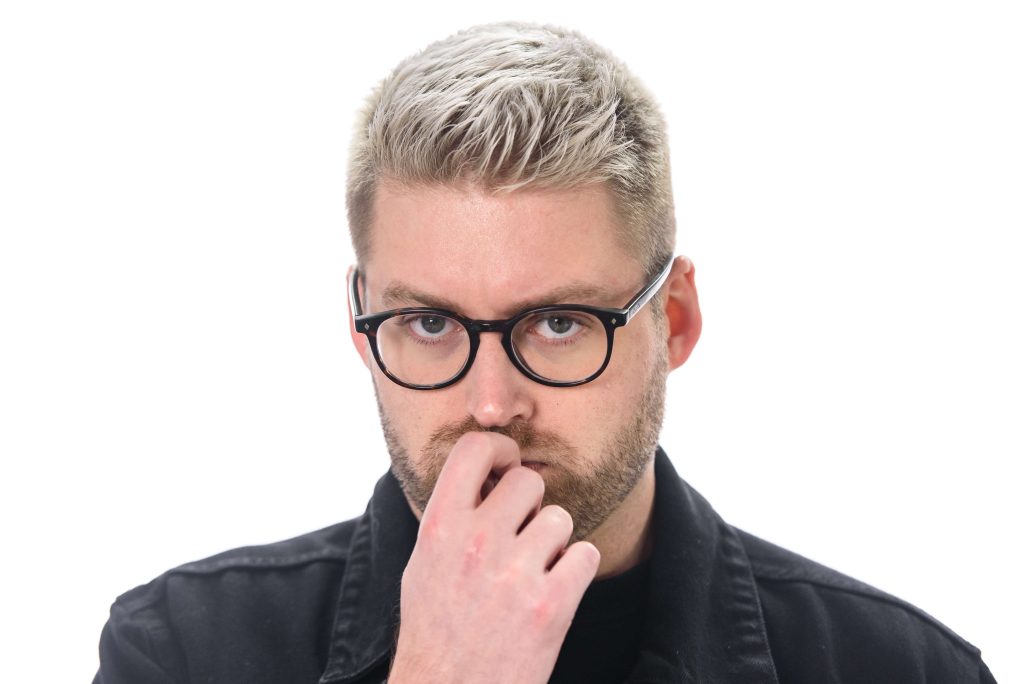
↑ Table of Contents ↑
My nails are yum
This gesture can be done with either one or two hands and is done with the fingers curled while the nails flick together5. Or they can simply be chewed to death.
What it Means: Picking at nails is a bad habit that I'm guilty of. It's a pacifying gesture that's done when people are feeling anxious or stressed. It also is a dead giveaway—you can easily tell someone's a nail picker, even if they aren't actively picking, just by looking at their hands.
Pro Tip: Since I have lots of experience with this one, I found one easy method to stop my nail picking—I wore a rubber band on my wrist. Every time I caught myself biting or picking my nails, I would snap down on that band! Did it hurt? A bit. Did it work? Heck yes!
Now I can say I've gotten rid of my nail picking for good… all thanks to a little rubber band!
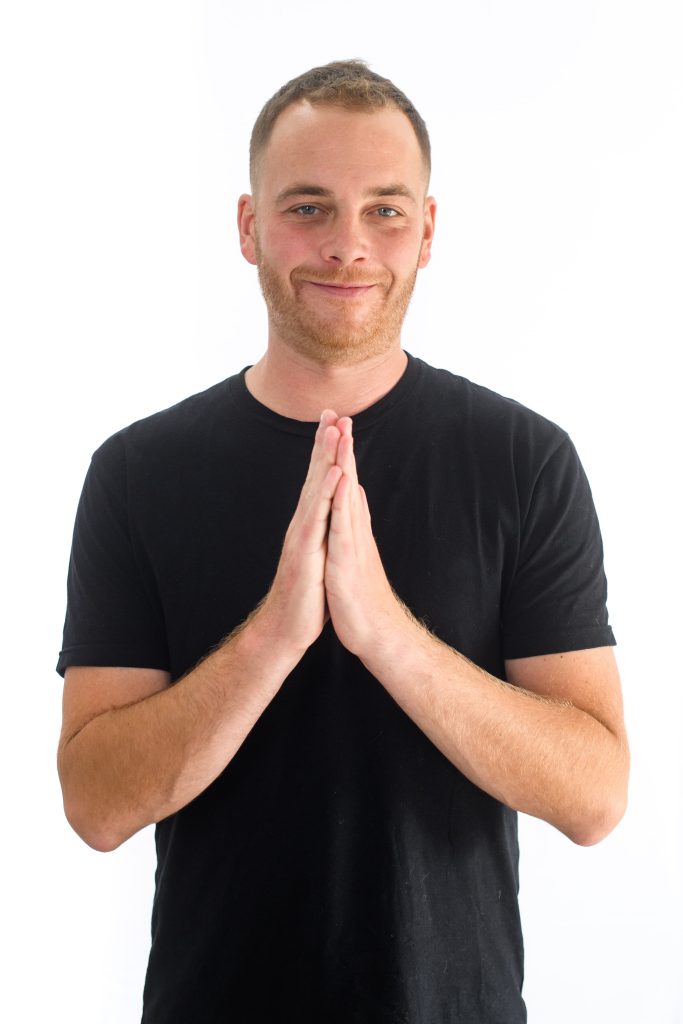
If you've ever prayed before, you know what this gesture looks like. It's super common in religious settings but is also used in interactions.
What it Means: Need to take a step down? Prayer hands is a natural humbling gesture that is used for forgiveness. Some cultures even use it as thanks, such as in the Japanese culture.
Thais will also use this with a slight bow, in a greeting known as the "wai." In this case, it's more respectful and even replaces the handshake.
Indians will also use prayer hands and say, "Namaste." Watch the next clip, as Donald Trump discusses doing the Namaste after coming back from India:
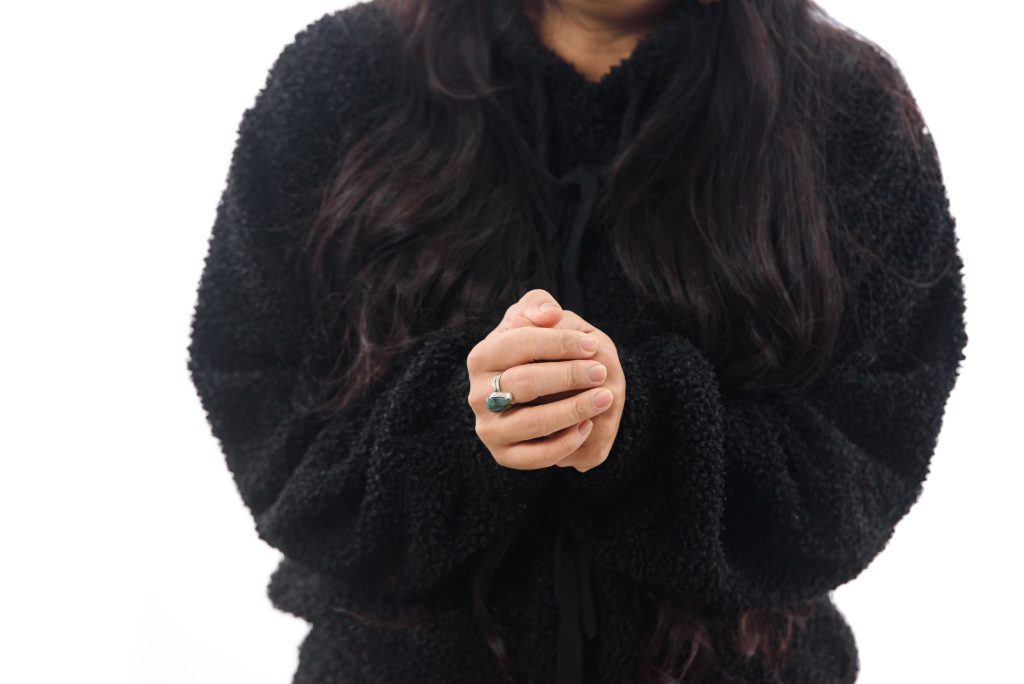
↑ Table of Contents ↑
Please, no!
What it Means: People clasp their hands when they've heard bad news or suddenly have a thought that causes them fear. Generally, it's not a good sign to see hands together, although it could also simply mean a person is cold.
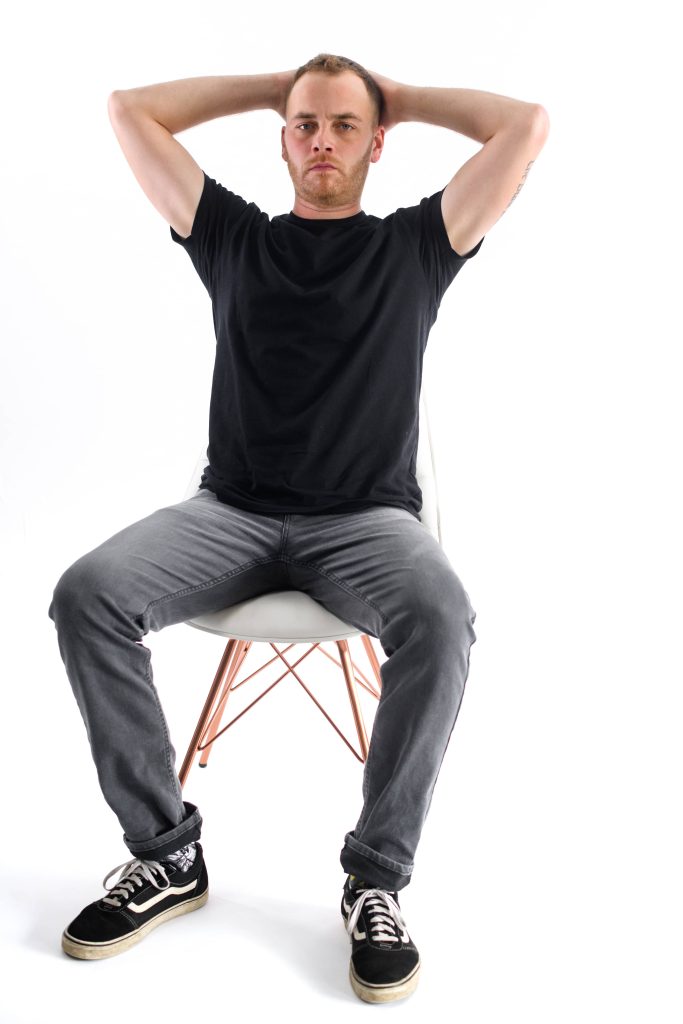
↑ Table of Contents ↑
I'm the boss
I'm the boss, or catapulting, is when someone sticks their hands behind their head. They may also be leaning back in a chair with their legs splayed out.
What it Means: This is usually a sign of confidence, especially when the elbows are flared out with other open body language.
It can also be a sign of being overwhelmed, however, if the elbows are pointed forward and covering a downward-pointing head.
How to Use it: Catapult to feel confident and in control. If you're the boss or manager, this may even come naturally to you! If you're around superiors, though, catapulting is probably the last thing that will come naturally to you. That's because this pose makes you physically big and is generally reserved for high-status individuals only.

↑ Table of Contents ↑
6 Other Hand-some Cues
OK, we've got the positive and negative out of the way. These are the remainders that didn't quite fit in either:

↑ Table of Contents ↑
Your hand appearance
Take a look at your hands. How do they shape up? Are they rough, smooth, calloused, scarred? Are the fingernails clean? Do you have a ring?
Indicators of the hands are everywhere3.
- Rough, calloused hands are an indicator that you do manual labor or lifting.
- Scars might mean you work on a farm, or they could be from athletic wounds received on the playing field.
- If you typically stand with your hands at the side with the fingers curled, this may indicate prior military experience.
- Calluses on the fingertips are common in guitar players.
- Manicured, clean fingernails indicate a high level of conscientiousness, while ratty, dirty, or bitten nails indicate nervousness, insecurity, and high neuroticism.
- Long nails are an effeminate indicator on men.
- A ring can be symbolic of different things—marriage, family lineage, school affiliation, and group belonging, to name a few.
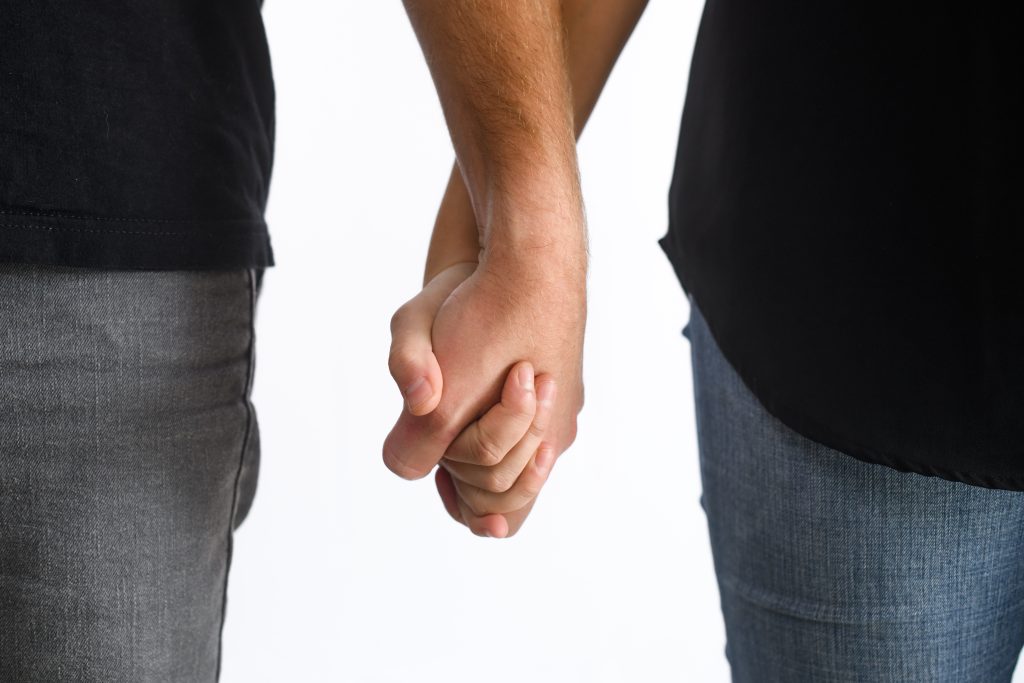
↑ Table of Contents ↑
Intertwined hands
How do you hold hands? We only hold hands with those we are close to, but there's a way to holding hands that you may not know about.
What it Means: Generally, simply clasping a person's hands is not as intimate as interlacing fingers with them5. This is because interlaced fingers is more stimulating, as more nerves in the hands make contact. You can observe a couple's hand holding as a general gauge of how close or serious a partnership is.
Hand holding is also very common among female friends and even close male friends, especially in Egypt, Saudi Arabia, and Vietnam.
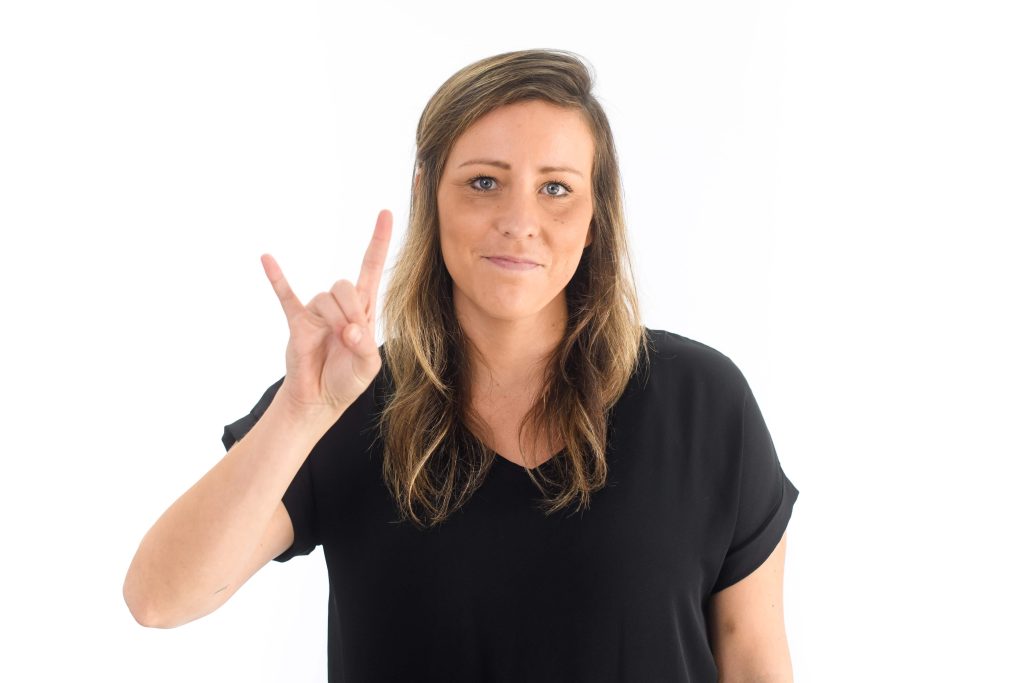
↑ Table of Contents ↑
Hook 'em horns
The "hook 'em horns" sign is popular among students and staff at the University of Texas at Austin. This hand gesture was also used by President George W. Bush on Inauguration Day in 2005… but little did he know there would be international backlash around this.
What it Means: This "friendly" gesture is interpreted by many Latin American countries as telling someone that their spouse is cheating on them. It's definitely not a good sign for presidents to use or if they're making a big public appearance in Latin America.
However, it can also mean "I love you" if you perform it with the thumb outward1.
What happens when someone touches us? Hopefully, it's not unwanted. If we like it, we may even feel inclined to touch them back in return.
What it Means: People touch others when they want social harmony. Other times, they may be seeking comfort or reassurance from you. You'll often see touching happen from a supervisor before an employee is fired or in a dating relationship when a breakup is about to occur5.
And according to science, humans are wired to decode touch. We can literally feel emotions just by touch alone:
- Sympathy is associated with stroking and patting.
- Anger is associated with hitting and squeezing.
- Disgust is associated with a pushing motion.
- Fear is associated with trembling.
How to Use it: Just like the Ben Franklin effect, where asking for a favor may net us a favor in return, touching someone may make them feel more inclined to touch us back. I found the best kind of touch is a light touch, lasting one second or less, on the upper arm area. This can help with flirting, being perceived as more friendly, or even help you in business meetings.

↑ Table of Contents ↑
Touch me, please
What it Means: When the desire to touch someone is transferred to an object (usually early on in the courtship process), you may notice your date stroking their arm or repeatedly sliding their fingers up and down a glass.
This is a subconscious flirting signal and stress reliever. You may see this cue in first date couples who are dying to get it on! Pick up on the right flirting cues, and you may not even have to rely on luck.
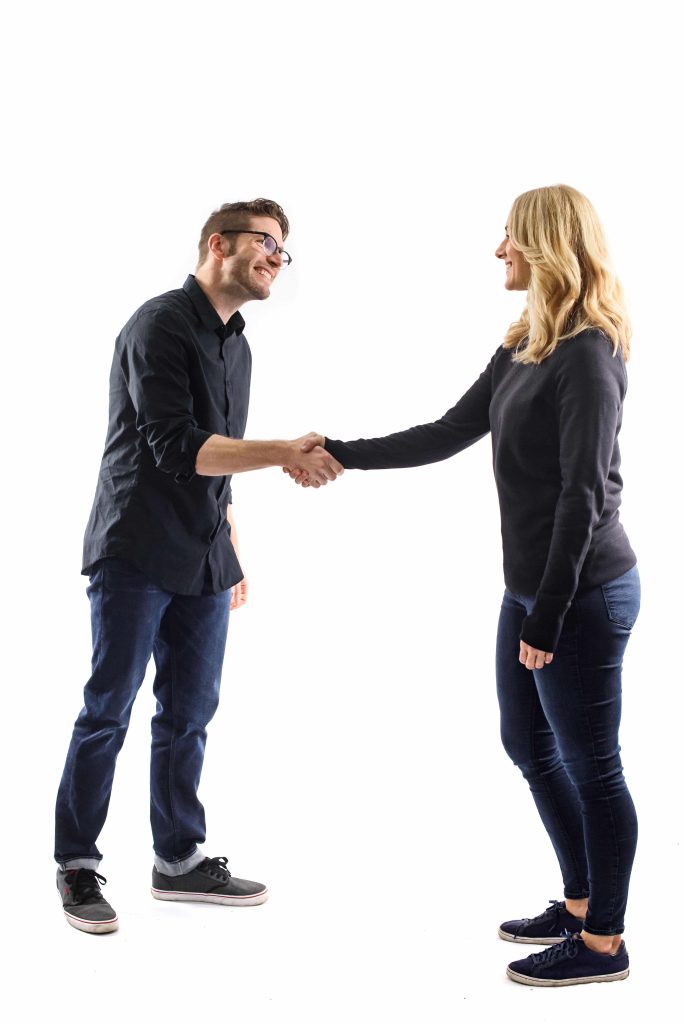
↑ Table of Contents ↑
The handshake
The handshake is one of the most widely used hand gestures in the West during first interactions and also one of the most important cues.
What it Means: Shaking hands is usually done between newly acquainted people and declines as the relationship grows; old friends will shake hands less and less6. However, it's important to shake when meeting someone, as it is a great warmth builder.
When the handshake was eradicated with the introduction of the Hitler salute, for example, this signaled a willingness to follow the Nazi party's rules. This eventually wounded the sociability and connectedness among Germans of that era1.
Shaking hands even originated way back in the Roman times, where 2 leaders would meet, greet, and even arm wrestle while standing2! Pretty hard core, right?
The stronger leader would finish with their hand above the other's hand, known as upper-hand position. You'll often see this in business deals and famous politicians toda5.
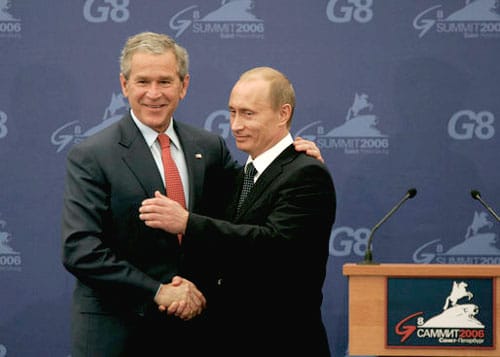
You can even tell personality traits from a person's style of shaking. A 2001 study by William Chaplin of the University of Alabama found that extroverts tended to use firm handshakes, while shy neurotics didn't. Also, women open to new ideas used firm handshakes, while men used the same handshake whether they were open to new ideas or not.
But do you know what's worse than no handshake at all? A bad one. A cold, clammy handshake can literally break rapport in milliseconds.
How to Use it: First off, if you're not the one initiating handshakes, start doing it. The Peases conducted a study of 350 successful senior management executives (89% of whom were men) and found that almost all managers initiated the handshake.
On top of that, 88% of men and only 31% of women used the dominant handshake position. Why? Because some women will give a soft handshake in some social contexts to imply submissiveness and highlight their femininity or imply that they can be dominated.
But in business situations, this is not a good idea because men won't take them seriously.
To prevent an unequal balance of power, a good rule of thumb is to apply the same tension and strength in the handshake as you receive.
Older people generally require less pressure, while higher-status individuals will set the tone for length and pressure to apply. You can even add a warm embrace to the handshake. Slow-motion analysis shows that even when shakers are nonembracers, there is a perceptible body-leaning toward each other—small, telltale intention movements of embracing6.
Now here's how to perform the perfect handshake in 7 steps:
- Maintain good eye contact.
- Smile, if appropriate.
- Extend your arm with a slight bend at the elbow.
- Point your hand downward as you move your fingers toward the other person's hand.
- Clasp hands, with equal pressure.
- "Engulf" each other to release oxytocin.
- After a second or so, release.
But don't shake when it's unwanted. Salespeople learned early on that a handshake when unannounced or uninvited can produce negative results, as the buyer might not want to welcome them and feel forced into a handshake2.
So the solution? Use a head nod instead. Or wait for the buyer to initiate a shake first.
↑ Table of Contents ↑
Bonus: Complete List
Want a super complete list? Wikipedia has a surprisingly good list of hand gestures that might be helpful. Remember: this list is not curated, so use them prudently.
↑ Table of Contents ↑
Practicing with Hand Gestures
I hope that you got some great ideas for hand gestures in this post. Want some extra practice? Watch the video below to practice everything you've learned in this article:
And make sure to never use these hand gestures in certain countries. Practice your positive gestures with:
- your elevator pitch
- your next presentation
- sharing your ideas
If you truly want to connect and understand people, they will remember you and feel good about being with you. This is all related to influence.
Sources:
1 Knapp, M. L., & Hall, J. A. (2014). Nonverbal communication in human interaction. Boston: Wadsworth Cengage Learning. 2 Pease, A. (2017). The definitive book of body language: How to read others' attitudes by their gestures. London: Orion. 3 Navarro, J., & Karlins, M. (2015). What every BODY is saying: An ex-FBI agent's guide to speed-reading people. New York, NY: Harper Collins. 4 Driver, J. & van Aalst, M (2011): You Say More Than You Think: The 7-day Plan for Using the New Body Language to Get what You Want. New York 5 Navarro, J. (2018). The dictionary of body language: A field guide to human behavior. New York, NY: William Morrow, an imprint of HarperCollins. 6 Morris, D. (2012). Peoplewatching: The Desmond Morris Guide to Body Language. London: Vintage Digital.
Side Note: As much as possible we tried to use academic research or expert opinion for this master body language guide. Occasionally, when we could not find research we include anecdotes that are helpful. As more research comes out on nonverbal behavior we will be sure to add it!
This article is part of our body language guide. Click here for more.
Why Are Hands So Hard To Draw
Source: https://www.scienceofpeople.com/hand-gestures/
Posted by: shriversincy1977.blogspot.com

0 Response to "Why Are Hands So Hard To Draw"
Post a Comment